
1
Plant Science Bulletin 56(1) 2010
SPRING 2010
VOLUME 56
NUMBER 1
PLANT SCIENCE
ISSN 0032-0919
The Botanical Society of America: The Society for ALL Plant Biologists
THE BOTANICAL SOCIETY OF AMERICA
Leading Scientists
and
Educators
since 1893
2010, The International Year of Biodiversity.............................................................2
News from the Society
Congratulations to the new BSA “AAAS Fellows”...................................2
American Journal of Botany launches new section for Primer Notes and
Protocols.....................................................................................3
Approaching deadlines for 2010 Award Nominations...............................4
Call for Nominations: BSA Corresponding Members................................4
IF YOU HAVEN’T DONE SO YET.........................................................4
Addendum...................................................................................................4
Student News..............................................................................................5
BSA President’s letter to Office of Science and Technology Policy..........6
BSA Science Education News and Notes...................................................8
Education Committee..................................................................................9
News from the Sections
Economic Botany......................................................................................10
Historical...................................................................................................10
Teaching....................................................................................................11
Northeastern .............................................................................................11
Personalia
David Dilcher awarded honorary University of Minnesota doctorate.....13
Courses/Workshops
Experience in Tropical Botany.................................................................14
Other News
Hunt Institute host annual Linnaeus Link meeting...................................15
Kew discovers new plant species in one of its own glasshouses.............15
Reports and Reviews
Botany in Romania, Highlighting its Endangered Plant Species..............15
Using Bottles to Study Shade Responses of Seedlings and Other
Plants........................................................................................................23
Books Reviewed in this Issue
................................................................................30
Books Received
.......................................................................................................47
American Journal of Botany Certificate
.............................................................47
Botany 2010
.............................................................................................................48
BULLETIN

2
Plant Science Bulletin 56(1) 2010
P
LANT
S
CIENCE
B
ULLETIN
POSTMASTER: Send address changes to:
Botanical Society of America
Business Office
P.O. Box 299
St. Louis, MO 63166-0299
E-mail: bsa-manager@botany.org
Address Editorial Matters (only) to:
Marshall D. Sundberg, Editor
Dept. Biol. Sci., Emporia State Univ.
1200 Commercial St.
Emporia, KS 66801-5057
Phone 620-341-5605
E-mail: psb@botany.org
ISSN 0032-0919
Published quarterly by Botanical Society of America, Inc., 4475 Castleman Avenue, St. Louis,
MO 63166-0299. The yearly subscription rate of $15 is included in the membership dues of
the Botanical Society of America, Inc. Periodical postage paid at St. Louis, MO and additional
mailing office.
News from the Society
What better way is there to begin a celebration
of the International Year of Biodiversity than to
feature the biodiversity of a little-known country,
in this case Romania. In our first feature article,
the BSA International Affairs Committee
presents another in its series of national
profiles. Co-authored by one of the Society’s
newest corresponding members, Anka Sarbu,
and by Anitra Thorhaug, chair of the BSA
International Affairs committee, Botany in
Romania showcases some of the endangered
species of this very central and large nation in
Eastern Europe that is little known to most
botanists and contains one of the few intact
forest systems in Europe.
In our second feature article, David W. Lee and
Eric von Wettberg present the inaugral peer-
reviewed paper published in the Plant Science
Bulletin
. This “bottle biology” project uses
commercially available shading materials to
differentiate plant responses between shading
conditions due to reduced light intensity alone,
or in combination with reduced R/Fr simulating
shading under plant cover. Modifications would
be appropriate for high school level through
college plant physiology courses.
The die for peer-reviewed articles in PSB is
now cast, but we depend on your contributions
for this effort to succeed.
- The Editor
Congratulations to the new BSA
“AAAS Fellows”
The Botanical Society of America is pleased to
recognize our members who have recently been
elected as fellows of the American Association
for the Advancement of Science (AAAS).
Election as a Fellow of AAAS is an honor
bestowed upon members by their peers in
recognition of their efforts to advance science or
its applications. Our colleagues will be among
the 531 members recognized at the Fellows
Forum on 20 February 2010 during the AAAS
Annual Meeting in San Diego.
For pioneering research into germination and
development of plants and exemplary
leadership in campus administration and
professional societies.
Dr. Darleen DeMason
University of California, Riverside

3
Plant Science Bulletin 56(1) 2010
Editorial Committee for Volume 56
Dr. David Spooner
University of Wisconsin-Madison
Nina L. Baghai-Riding (2010)
Division of Biological and
Physical Sciences
Delta State University
Cleveland, MS 38677
nbaghai@deltastate.edu
P
LANT
S
CIENCE
B
ULLETIN
Jenny Archibald (2011)
Department of Ecology
and Evolutionary Biology
The University of Kansas
Lawrence, Kansas 66045
jkarch@ku.edu
Root Gorelick (2012)
Department of Biology
Carleton University
Ottawa, Ontario
Canada, K1H 5N1
Root_Gorelick@carleton.ca
Elizabeth Schussler (2013)
Department of Ecology and
Evolutionary Biology
University of Tennessee
Knoxville, TN 37996-1610
eschussl@utk.edu
Christopher Martine
Department of Biology
State University of New York
at Plattsburgh
Plattsburgh, NY 12901-2681
martinct@plattsburgh.edu
For distinguished work in
systematics, evolution, and
the domestication of
potatoes, tomatoes and their
wild relatives.
For distinguished contri-
butions to the field of
evolutionary ecology,
including the evolution of
reproductive systems in
plants and the quantative
genetic basis of sex
allocation.
American Journal of Botany
launches new section for
Primer Notes and Protocols
The American Journal of Botany (AJB) has just
launched a new online-only section: AJB Primer
Notes & Protocols in the Plant Sciences. This
new section will promote the rapid
dissemination of protocols used in the genetic
analyses of plants.
Articles for this section will include marker
notes, which provide primer sequences for
microsatellite or other markers in particular
taxa, and protocol notes, which describe new
methods for isolating, visualizing, or scoring
genetic markers.
“It is exciting to now have the opportunity to
publish innovative and timely genetic
information within such an influential journal
as the AJB,” said Theresa Culley, Associate
Professor at the University of Cincinnati. ”Plant
biologists now have a new outlet with a rapid
response rate and greater flexibility where they
can share their important genetic discoveries
within the botanical community.”
-continued on Page 13
For outstanding contributions
to science education,
particularly inquiry activities
involving plants and
undergraduate research
experiences.
Dr. Susan Singer
Carleton College
Dr. Stephen Weller
University of California,
Irvine

4
Plant Science Bulletin 56(1) 2010
Approaching deadlines for
2010 Award Nominations
March 15
th
BSA Awards - General
BSA Merit Award
http://botany.org/awards_grants/calls/
2007merit.pdf
Charles E. Bessey Teaching Award
http://botany.org/awards_grants/calls/
2007bessey.pdf
BSA Awards - Students
Young Botanist of the Year
Undergraduate Student Research Awards
John S. Karling & BSA Graduate Student
Research Awards
Genetics Section GSRA
April 1
st
BSA Award - General
Jeanette Siron Pelton Award
Darbaker Prize
BSA Student Travel Awards
Triarch “Botanical Images” Awards
Vernon I. Cheadle Awards
Section Travel Awards: Developmental and
Structural, Ecological Section, Genetic
Section, Mycological Section, Phycological
Section, Phytochemical Section, Pteridological
Section .
Call for Nominations: BSA
Corresponding Members
Deadline April 1, 2010
The Corresponding Members Committee is
soliciting nominations for Corresponding
Members of the BSA. According to the BSA
Bylaws, Corresponding Members are
“Honorary members working as professional
botanists in foreign posts, who by virtue of their
contributions, are elected by the membership
of the Society.” Corresponding Members are
granted life membership in the BSA and enjoy
all the privileges of regular Active Members.
The nomination should consist of 1) a
curriculum vitae of the proposed candidate, 2)
a detailed explanation of the qualifications
and achievements of the candidate, and 3) at
least three (eight to ten are usual) letters of
Addendum
Otto Stein makes a minor correction to a
misstatement in PSB 55(4):151 noting that
there is another recent Northeast Plant Taxa
publication - - Dennis W. Magee and Harry E.
Ahls, Flora of the Northeast. See PSB 54(4) for
a review of this work.
support.
It is preferable for nominations to be made
without knowledge of the nominee. Nominations
must be received by 1 April 2010
to be
considered for award of corresponding
membership at Society business meeting at
the Botany 2010 Conference in Providence,
Rhode Island, on Tuesday, August 2, 2010.
Please use the nominating form available on
the BSA webpage at:
http://botany.org/membership/Call-
CorrespondingMembers.asp
Please email all other materials as PDF files
to the BSA Executive Director at
wdahl@botany.org
.
Thank you for your contributions
. Chair,
Corresponding Members Committee - Dr. Karl
Niklas, Past President
For additional information or questions,
contact:
William M. Dahl,Executive Director
Botanical Society of America
E-mail:
bsa-manager@botany.org
IF YOU HAVEN’T DONE SO
YET...
Please take a few minutes to renew your
membership or join the BSA
. We also
encourage you to give a student gift
membership to a student who is interested in
joining the BSA
! A gift membership for NEW
student members is only $10.
Welcome to ChloroFilms!
A WORLD-WIDE, OPEN COMPETITION FOR
PLANT BIOLOGY VIDEOS ON YOUTUBE
TM
CONTEST #3
Deadline: 15 April 2010
www.ChloroFilms.org

5
Plant Science Bulletin 56(1) 2010
Botanical Society
Undergraduate Student
Research Awards
Purpose and Eligibility
This award is designed to promote
undergraduate student research in the
botanical sciences in conjunction with our
efforts to highlight the plant sciences as a
study and/or career option. We see this as a
simple and effective way of promoting your
research, your lab, your university and your
passion for the botanical sciences. It is meant
to be a fun and informative activity.
To be eligible, one must be a student member
of the Botanical Society of America (BSA), a
registered undergraduate student, have a
faculty research advisor who is also a member
of the BSA, and not have won the award
previously. Please note: Award Recipients will
be eligible to participate in the BSA Graduate
Student Research Award program as a
Graduate Student.
Award Level and Announcement
It is anticipated that 10 awards will be given this
year. The award will provide $200 to support
each recipient’s research proposal. Up to three
“proposals of excellence” may be eligible to
receive $500. The award winners will be posted
online, noted in the Plant Science Bulletin and
announced at the BSA banquet held in
conjunction with the Botany 2010 Meeting in
Providence, Rhode Island, on August 4, 2010.
Please note
: All winning proposals will be
peer-reviewed for accuracy and placed online
as part of the BSA “BOTANY - science from
students’ perspectives
” portfolio. Judges will
make decisions on proposals as they come in.
Winning proposals will go online immediately
following peer review.
Proposal Guidelines
The application shall consist of:
1.
Title page
- must include: title of
proposal, name of student, student’s
institutional and departmental affiliation, year
of student’s study, and student’s sectional
affiliation within BSA.
2.
A narrative
- must be between 1,200
- 2,000 words, which includes a description of
the research, including appropriate conceptual
background, purpose or objective, brief outline
of methodology, the potential contribution or
significance to an area of the botanical sciences,
and a bibliography. The narrative should be
written in Microsoft Word in Times New Roman
11 point font.
3.
Images/Videos
- As successful
applications become part of the “BOTANY -
science from students’ perspectives
”
portfolio, we strongly encourage you to support
your written narrative with images. Images are
to be emailed directly to the BSA office and must
be of high quality in a size range from 1-5 MB.
We will also support links to videos placed on
YouTube. In fact, we encourage you to use a
multi-media approach to show the wonders of
science.
4.
Budget
- (one page maximum)
detailing how the funds would be used.
5.
A letter of support
- (one page
maximum) from the student’s research advisor.
Submissions
Proposals and supporting letters must be
received between January 1 and March 15,
2010
.
Submit required materials by email as a WORD
or PDF file to
bsa-manager@botany.org.
Please ask advisors to do the same.
Please feel free to contact us if you have any
questions -
bsa-manager@botany.org
.
Student members are encouraged to contribute
to the Undergraduate Student Research Award
program through the BSA web site. Please
contact the Executive Director for further details.
1.) Time to be acting on award applications!
There are many award opportunities offered to
students throughout the BSA. We encourage
you to check out what you can apply for and to
get your applications in now. If you receive this
message in plain text, go the
Botany.org
for more information. Only current BSA
members are eligible for these awards so
make sure you renew prior to submission.
Due March 15, 2010
Call for Proposals - Student Research Awards
» BSA Graduate Student Research Awards
» BSA Undergraduate Student Research
Awards
Student News
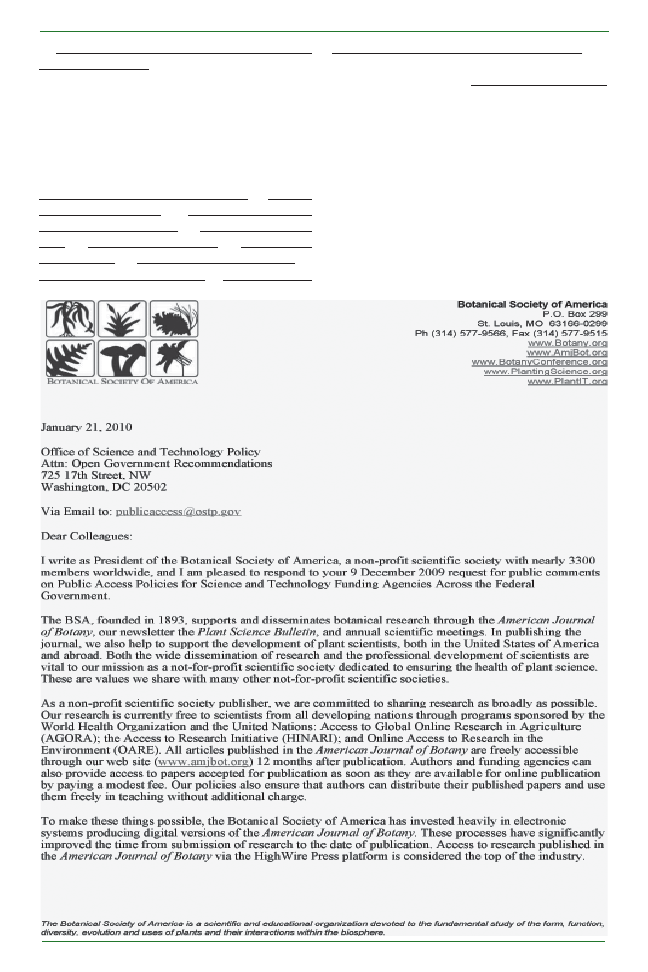
6
Plant Science Bulletin 56(1) 2010
» Genetics Section Graduate Student
Research Awards
UNDERGRADUATES please note
: IN ADDITION
TO TEN $200 AWARDS, UP TO THREE
ADDITIONAL RESEARCH AWARDS MAY BE
PROVIDED via the BSA GSRA program at the
$500 level for “proposals of excellence”.
Due April 1, 2010
Triarch “Botanical Images” Awards | Vernon
I. Cheadle Awards | Developmental and
Structural Section STA | Ecological Section
STA | Genetic Section STA | Mycological
Section STA | Phycological Section STA |
Phytochemical Section STA | American Fern
Society & BSA Pteridological Section STA
There are already a few TRIARCH submissions
coming in. Get your images in early and get in
often on this one!
2.) Nomination for Student Representative to
the BSA Board
Please take a few minutes to consider who
you’d like to represent student members on the
BSA Board and send your nominations to Bill
Dahl at the BSA office -
wdahl@botany.org
.
We’ll then submit our nominations as part of
the 2010 BSA Elections of Offices ballot in
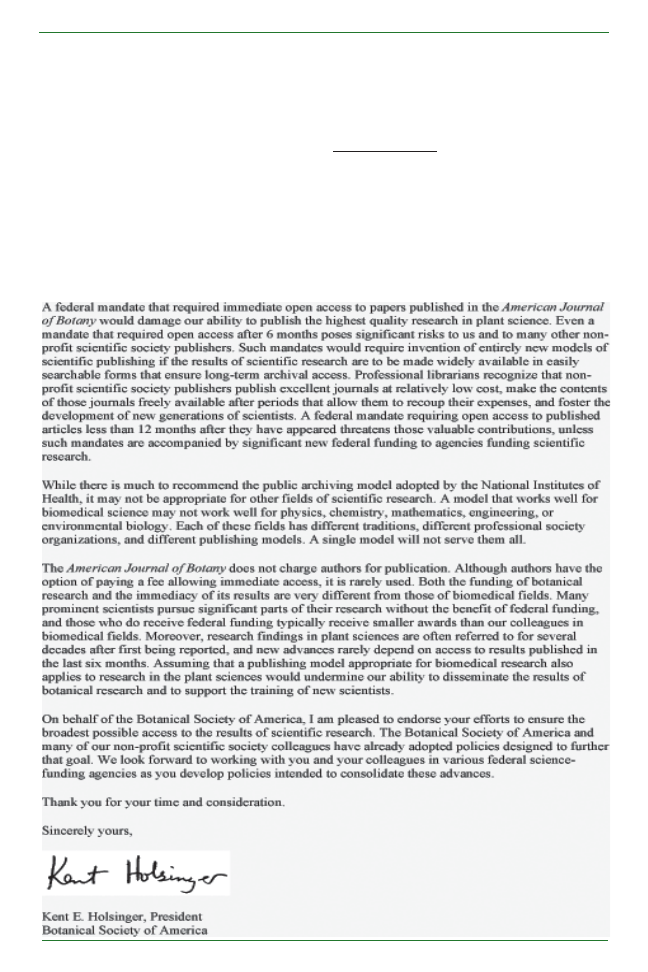
7
Plant Science Bulletin 56(1) 2010
February.
3.) Remember, it’s membership renewal time
and we have not received your dues for 2010
You need to be a member for the awards
noted above. Please take the time to renew
now and keep the benefits of being a BSA
member coming. We also encourage you to
give a gift membership to another student
who is interested in joining the BSA
! A gift
membership for NEW student members is
only $10. Thank you for being part of this great
community.
https://crm.botany.org/
joinbsa/
4.) PlantingScience
Looking for a great way to participate in BSA
activities, helping kids learn about botany,
while giving to the scientific community at the
same time?
We’d love to have you join us as a
PlantingScience
mentor! It looks good on your
CV, you become familiar with materials that are
effective for teaching botany, and it is a rewarding
experience to turn kids on to science. Check out
the website at:
www.PlantingScience.org
and
become a mentor at:
www.PlantingScience.org/
NewMentor/
5.) ChloroFILMS - We’re back!!!

8
Plant Science Bulletin 56(1) 2010
BSA Science Education
News and Notes
Contest THREE is in full swing. Big money was
won in contest TWO. Go to
www.ChloroFILMS.org
for more information
and to submit your entry.
Graduating?
Look at the Jobs page on
Botany.org/newsite/Employment/
.
See you in Providence this summer
!!! Watch
for further emails about the meeting.
Your BSA reps, Jim and Rachel
Rachel Meyer Jim Cohen
Rmeyer@nybg.org
jic24@cornell.edu
Student Representatives
Botanical Society of America
BSA
-
botany.org
BSA Science Education News and Notes is a
quarterly update about the BSA’s education
efforts and the broader education scene. We
invite you to submit news items or ideas for
future features. Contact: Claire Hemingway,
BSA Education Director, at
chemingway@botany.org
or Marshall
Sundberg, PSB Editor, at
psb@botany.org.
PlantingScience
— BSA-led student
research and science mentoring program
Your contributions as a PlantingScience
mentor directly touch the lives of the students
and teachers in the online learning community!
They tell us so:
“I liked that we got to actually plant the plants
and do hands on stuff and I liked how we got to
talk with the real scientists and learn more.” -
student in Fall 2009 session
“It has helped me to change the way I teach all
grades in the classroom. I don’t give answers
anymore, I lead discussions and let them
research and guide them through their thought
processes.” –
teacher in Fall 2009 session
During the recent Fall 2009 online mentored
inquiry session, over 178 scientists mentored
338 student teams from 25 middle school
through college classrooms across 18 states.
The Wonder of Seeds investigation of
germination remains the most popular inquiry
module among classrooms, but we continue
to develop and field-test new modules each
year. Modules in field-testing during the fall
included pollination and both the Brassica and
Arabidopsis
strands of genetics.
Our thanks to the scientists and teachers who
made the Fall session a valuable opportunity for
students to experience science in their
classroom as it is conducted by working
scientists. Over the winter break between
sessions, we welcomed over 100 new mentors
to the program. The Spring 2010 Online Session
runs February 15-April 30, 2010. We welcome
you to share your passion for plants and botany!
PlantingScience Summer Institute for Teachers
June 21-29, 2010. Texas A&M University.
High school and middle school teachers, we
invite you to join botanists Marshall Sundberg
and Renee Lopez-Smith and teachers from
across the country to explore new
PlantingScience inquiry modules: celery (cell
structure, function, response to the environment)
and C-Ferns (reproduction and life cycle). The
Institute offers you opportunities to immerse in
the inquiry experience, engage in the online
platform, share strategies for using science talk
and notebooks with your students, and develop
a plant to take any of new or existing inquiry
modules to your classroom.
Apply online by April 9
.
http://
w w w . p l a n t i n g s c i e n c e . o r g / i n s t i t u t e -
application.html
Plant IT Careers, Cases, and Collaborations
The Plant IT project (
http://www.myPlantIT.org
),
a collaboration among the Botanical Society of
America, BioQUEST Curriculum Consortium,
and Texas A&M University, is nearing the end of
its funding from the National Science
Foundation. This July will be the final
opportunities for a two-week teacher summer
professional development workshop, open to
teachers from across the country, and a one-
week student career camp, especially for Texas
high school students. We look forward to sharing
with you final products and full lessons learned
from this project as these become available.
In the meantime, we offer a few tantalizing
preliminary findings about the 2009 summer
camp students’ knowledge and interest in plant
careers. Student responses to the question
“What do people who work with plants do?”

9
Plant Science Bulletin 56(1) 2010
showed an increase in the average number of
plant-related careers from pre- to the post-test.
The diversity of careers mentioned also
changed, with students aware in the post-test
of opportunities in academics, science media,
greenhouse management, landscaping and
plant retail positions. Of the 25 students, 16
could see themselves as a scientist both when
they arrived and departed, and 3 came to view
during the course of the session. For these
students, the many faces of botany are now
revealed and closer in reach. One student
cited the many things they learned at MyPlantIT
as the reason for wanting to be a scientist.
Final Plant IT Summer Institute for Teachers
July 12-23, 2010. Texas A&M University.
Bioinformatics and textile forensics will be the
focus of investigative cases presented by
botanist Ethel Stanley and high school master
teacher Toni Lafferty as models for high school
and middle school teachers interested in
learning to use plant-related cases with their
students. Participants will discover new
resources, tools, and data for your students,
collaboratively develop cases, and practice
new skills working with students participating
in a summer camp. We invite you to join the fun.
Apply by April 9.
http://www.MyPlantIT.org/
institute-application.html
Science Education Bits and Bobs
National Lab Day: An effort to scale hands-on
learning across the country
— Improving STEM
(Science, Technology, Engineering, and
Mathematics) education is again a national
priority, backed by federally funded and private
initiatives. National Lab Day (NDL) is intended
to engage volunteers — university students,
scientists, engineers, other STEM
professionals, and community members — to
collaborate with educators and students to
improve labs and discovery-based science
experiences for students in grades 6-12. The
Botanical Society of America was a signatory of
the letter to President Obama supporting this
endeavor. The NDL website provides a means
to match teacher needs with scientists who
can help. A celebration of National Lab Day
activities is planned for May 2010.
http://www.nationallabday.org/
Making science relevant boosts high school
students with low science confidence
— In the
4 December 2009 issue of Science, Hulleman
and Harackiewicz present evidence that a
simple writing intervention, in which students
were encouraged to make connections
between the science course material and their
own lives, led to greater interest and higher
grades. Students from two high schools in a
small Midwestern city were randomly assigned
either to simply summarize the science content
recently covered in class or to write about how
the content is useful in their own lives. The act
of making science personally relevant was
motivating for students who initially lacked
confidence, but did not have a statistically
significant impact on students who had a high
expectation of success in science prior to the
intervention.
http://www.sciencemag.org/cgi/
content/abstract/326/5958/1410
Why do students leave college without
finishing?
— The stress of balancing work and
study and carrying the financial burden of
college tuition without additional support are
two frequent reasons given for students to
leave college, according to a recent report by
Public Agenda based on nation-wide survey of
22-30 year olds. With their Whole Lives Ahead
of Them
is the first of three anticipated reports
supported by the Bill and Melinda Gates
Foundation to describe how American youth
view higher education.
h t t p : / / w w w . p u b l i c a g e n d a . o r g /
theirwholelivesaheadofthem
Where are graduate enrollment numbers of
international students going?
— After several
years of steady growth, 2009 saw a flattening
of enrollment by international students in U.S.
graduate institutions, along with a 6 % increase
in American first-year students, according to a
recent report by the Council of Graduate
Students. Enrollment decreases were striking
among students from India and South Korea,
while the steady increases among students
from China and the Middle East and Turkey
was maintained. In the life sciences, the percent
change from 2008 to 2009 in international
student enrollment numbers differed
substantially according to the size of the
institution, ranging from 19% at the 10 largest
institutions to 6% at all institutions excluding
the 100 largest.
Access the report:
http://
w w w . c g s n e t . o r g / p o r t a l s / 0 / p d f /

1 0
Plant Science Bulletin 56(1) 2010
News from the Sections
Economic Botany Section
(EBS)
EBS embraces all aspects of plant use,
including classic Economic Botany,
Ethnobotany, Ethnopharmacology etc. The last
year has been very exciting for the section,
helping to establish new links to our sister
societies with interests in Economic Botany,
and many options for future collaboration.
Within BSA EBS and Historical Section plan to
collaborate closer. A first effort will be the
organization of a joint symposium focusing on
Economic Botanists in the New England States
for the 2010 meeting in RI, as well as joint field
trips highlighting important collections in the
region. Similar efforts will be planned for the
meeting in St. Louis 2011.
The last membership assembly voted
unanimously to establish a fee for membership
in EBS. The new fee is set at US$ 2.00 and will
be used to improve student participation by
establishing:
-Student travel awards: EBS will award an
amount of a total of US$ 500 for two student
travel awards. The awards will be given
according to the respective actual travel finance
needs of two students, and are awarded by the
section chair. Preference will be given to
undergraduate students.
- Student presentation award: EBS establishes
a US$ 100 award to be given for the best student
paper presentation. An ad-hoc panel of three
(3) members present, selected by the section
chair, will serve as judges.
Upcoming Elections:
In 2010 we’ll have to elect a new treasurer/
secretary, as Felix Coe’s term comes to an end.
Felix has done a great job during the last years
- many thanks for that!! Any suggestions for
candidates are welcome.
Dr. Rainer W. Bussmann, Chair
e-mail:
rainer.bussmann@mobot.org
Education Committee
In addition to his formal address to the
conference, Dr. Ken Miller will participate in a
discussion of teaching evolution at Botany
2010. The session is scheduled for Sunday
morning and it is free. We are asking that you
register to attend. Watch for this option when
you register for the Annual Meeting. Bring your
success stories and challenges to share in
what will surely be a lively and informative
discussion.
The Education Committee is taking on new
challenges and looking for members who can
help us move our ambitious agenda along.
Please seriously consider how your skills
might help the Society increase the number of
quality botanical education resources available
to members and non-members alike.
We are developing a format for submission,
review and posting of online resources that are
substantial and compelling, so that whenever
someone wants to add botanical information
to a course the first place they think of looking
is the Botanical Society’s website. We also
see this as an excellent way for researchers to
meet grant requirements for outreach. Here
are two of the projects we are pursuing:
Developing a peer-reviewed, searchable
database of K-16 curricular resources
This project could have tremendous impact.
We are currently developing guidelines for
submission, review and posting. If you would
like to help shape this project, we would love
to have your help.
Developing a documented, searchable image
database with comments and notes that make
the images useful to K-12 educators as well as
college instructors. If you can add information
on particular plants or images to yield better
search results, and/or create modified images,
perhaps with labels, or with blanks for labeling,
this would be a great fit for you. We also would
like input on developing a protocol for
submission and review images.
If you are interested in participating or have
other suggestions for initiatives, please contact
Beverly J. Brown, bbrown6@naz.edu.
R_IntlEnrl09_III.pdf
Learning Outside Classrooms and Dealing
with Data: New NAS Publications
— Two
recent reports from The National Academies
Press address characteristics of today’s
science experience: much learning about
science takes place outside the classroom in
botanic gardens, museums, and science

1 1
Plant Science Bulletin 56(1) 2010
Teaching Section
Make a note now that the Teaching Section is
sponsoring a symposium “Broader Impact:
Linking Basic Research and Education” at the
annual meeting. The goal for this symposium
is to provide the basic research communities
exemplary examples on how their activities
can be effectively linked to education, thus
fulfilling NSF’s Broader Impact criterion.
The speakers will be:
-Elizabeth Kellogg, University of Missouri- St.
Louis, Former NSF program officer
-Paul Williams, University of Wisconsin-
Northeastern Section
Joint Field Meeting of the:
BSA Northeastern Section
Torrey Botanical Society
Philadelphia Botanical Club
June 20-24, 2010 (Sunday-Thursday)
Buxton School, Williamstown, MA
The 2010 Field Meeting will explore the Botany
of Berkshire County, Massachusetts. We will
stay at Buxton School in the heart of
Williamstown, down the street from the famous
Sterling and Francine Clark Art Institute and
Williams College.
Accommodations are in the school dormitory
rooms in the main building and two other
buildings on campus. Men and women will
have separate facilities either by building or by
floor. Most rooms will have two, three or four
occupants and bathrooms are shared. Private
rooms for singles or couples will be hard to
come by, but we may be able to arrange
something depending on the registration
number. Also, if anyone would prefer a private
room with bath, the Williams Inn is just down
the street and will have rooms available for
$125 single and $145 double (plus tax) per
night. For this, you make your own
arrangements. All your meals would be at
Buxton.
The price of the field meeting will be $350
including four nights lodging and meals from
Sunday night thru Thursday breakfast. Linens
are included. Without room, price is $225.
HISTORY OF BOTANY IN THE RHODE
ISLAND AREA
Botany 2010 symposium
Historical, Economic Botany, Developmental and
Structural, Ecology, and
Physiological Sections
Dennis Stevenson
“Rhode Island: A historical perspective on its
Botany and Botanists”
Susan Danforth
“Botany at the John Carter Brown Library”
Rainer Bussmann
“I know every tree, every single tree one can
see…’ – The life and legacy of Richard E.
Schultes”
Angela Todd
“George H. M. Lawrence (1910-1978) and his
international impact on botany”
Gordon Tucker
“Irene Stuckey: a life well spent with plants and
people”
Philip Marshall
“Pinus strobus L. and the historical utilization
and management of southern New England
forests, 1600-1938.”
Ray Evert & Natalie Uhl
“Thoughts on Vernon I. Cheadle”
Annette Coleman
“Vignettes from the history of Brown botany”
Following the symposium there will be a field
trip to the John Carter Brown Library entitled
“Science and Economic Empire: European
Look at New World Resources in the 17
th
and
18
th
Century.”
For additional information please contact:
Marissa C. J. Grant,
mgrant39493@lakeland.cc.il.us
Madison, Wisconsin Fast Plants: Bringing
research a research organism to the classroom
-Anne W. Sylvester, University of Wyoming,
Genetics workshops at Little Bighorn tribal
college
-Karen Sue Renzaglia: Southern Illinois
University, Ceratopteris richardii: From model
system to classroom organism
-Dennis Wm. Stevenson, Vice President for
Botanical Science, Taxonomy research and
education (9-16)
-D. Tim Gerber, University of Wisconsin - La
Crosse, Department of Biology, Connecting
teachers to basic research
Stokes Baker, Chair, Teaching Section
Historical Section

1 2
Plant Science Bulletin 56(1) 2010
Please complete attached Registration Form and return to:
Karl Anderson, 46 North Childs Street, Woodbury, NJ 08096-1535
For further information contact: Chairperson Nan Williams, 413-339-5598 or
nnwrowe@gmail.com
.
2010 Joint Field Meeting Registration Form
Deadline May 15, 2010
Name(s):_______________________________________________________
_____________________________________________________________________________
Address:
______________________________________________________________________
______________________________________________________________________________
Phone:
______________________________________________________________________
Number of Participants X $350 basic rate $____________
Number of Participants X $225 without room $____________
Number of participants for day trips (no meals or rooms) X $100 $____________
Private room if available at Buxton? _________________________________________
Your check for the full amount made out to Botanical Society of America with the completed
Registration Form should be mailed to:
Karl Anderson, 46 North Childs St., Woodbury, NJ 08096-1535.
Phone: 856-845-7075.
Please include here the name of the person(s) with whom you wish to share a room or indicate
that we may assign roommates:
______________________________________________________________________________
Please include here the name and phone number of a person to be notified in case of an
Emergency
____________________________________________________________________________
Check membership(s) of the participant(s) named above in Botanical Organizations:
Botanical Society of America _____
Torrey Botanical Society _____
Philadelphia Botanical Club _____
Other (Organization
Name)
_____________________________________________________
In making this application, participants affirm that they are in general good health, are physically
able to keep up with the group in the ordinary course of field activities, accept as their personal
risk the hazards inherent in any outdoor activity, and will not hold the Botanical Society of America,
or other sponsoring organizations, or the trip leaders responsible for the same.
Signature and date:
______________________________________________________________
Field trips, by bus, will include Mt. Greylock, the
highest mountain in Massachusetts with its
own unique sub-alpine boreal forest and rare
plants, and Bartholomew’s Cobble, National
Natural Landmark, where “you’ll find one of
North America’s greatest diversity of fern
species” and many interesting plants amid
the unusual geology of the cobbles. Other trips
will depend on the best botanical locations at
the time. There will be a variety of evening
lectures.
We are fortunate to have as leaders Pam
Weatherbee, Berkshire County Botanist, and
Dr. C. Barre Hellquist, Biology Professor
Emeritus, Massachusetts College of Liberal
Arts.

1 3
Plant Science Bulletin 56(1) 2010
Personalia
David Dilcher awarded
honorary University of
Minnesota doctorate.
Alumnus David Dilcher, the world’s leading
authority on the evolution of flowering plants,
received an honorary doctorate from the
University of Minnesota on September 26, 2009
at Itasca Biological Station and Laboratories.
Dilcher’s lifelong passion for plant evolution
was sparked during time spent as a student at
the field station. After earning B.S. and M.S.
degrees at the University of Minnesota in 1958
and 1960, Dilcher went on to earn his doctorate
at Yale University. He spent most of his career
as professor of botany at the University of
Indiana before moving to the Florida State
Museum where, now retired, he continues his
work as an adjunct professor at the University
of Florida.
In 1998, Dilcher and a colleague at a Chinese
university uncovered a fossil of what they believe
to be the world’s oldest flowering plant, which
lived at least 125 million year ago. The
discovery, which secured Dilcher’s reputation
for solving what Darwin termed the
“abominable mystery” of how flowering plants
evolved from green plants and became the
dominant plant group on Earth, was featured
in an episode of Nova titled “First Flower.”
Text and photo from: BiO: College of Biological
Sciences Newsletter, University of Minnesota.
-continued from page 3.
For more information on the new section or to
submit an article for consideration, go to
h t t p : / / w w w . b o t a n y . o r g / a j b /
PNP_Online_instructions.html.
The first article appeared in the January issue,
which can be viewed at
http://www.amjbot.org/
cgi/content/full/97/1/e1.
This new section was
suggested in 2009 by the BSA Executive Board,
and the effort has been spearheaded by “PNP”
Editors Kent Holsinger, Pam Soltis, Theresa
Culley, and Mitch Cruzan.
This section is intended to promote rapid
dissemination of protocols used in genetic
analyses of plants. Appropriate subjects
include: (1) marker notes providing primer
sequences for microsatellite or other markers
in particular taxa, and (2) protocol notes
describing new methods for isolating,
visualizing, or scoring genetic markers.
Protocol notes are expected to provide evidence
that the new protocol increases the accuracy
or reproducibility of marker scoring, decreases
the time or expense of marker scoring, or
provides the ability to score new classes of
markers.
For a template and the complete instructions
for authors for this section, see
h t t p : / / w w w . b o t a n y . o r g / a j b /
PNP_Online_instructions.html
We also have a few changes in the general
instructions for authors (
http://www.amjbot.org/
misc/ifora.shtm
l). These changes include:
Structured Abstracts: Beginning in January
2010, we are asking authors to write their
abstracts in a structured format. This brings
the most important aspects of the study to the
beginning of the paper - it helps authors focus
their ideas and highlight key points, and it
helps readers decide quickly whether they
want to read further. See
h t t p : / / w w w . a m j b o t . o r g / m i s c /
ifora.shtml#63AbstractPage
for further
information
Open Access Options: Starting in January
2010 AJB authors have the option to make their
accepted paper freely available online
immediately upon publication. The fee for
Open Access is $1500 (discounted to $500 if
the author’s institution subscribes to the
Journal).
And finally, we are pleased to report that in
January, Judy Jernstedt began her second
term as Editor-in-Chief. We are grateful for her
continued dedicated service.

1 4
Plant Science Bulletin 56(1) 2010
Courses/Workshops
Experience in Tropical Botany
Harvard University Summer School, in
collaboration with The National Tropical
Botanical Garden, announces the following
course in 2010.
Dates
: June 13 to July 10, 2010
Location
: The Kampong Garden of the
National
Tropical Botanical Garden,
4013 Douglas Road, Coconut Grove,
Miami
FL 33133
The Class will use the newly-constructed
Kenan Teaching Laboratory at The Kampong
(wet bench and microscope facilities) and be
accommodated at the comfortable Tyson
dormitory (of Scarborough House) on the
same property.
Course title
:
Biology S-111. “Biodiversity of Tropical Plants”
Instructor
: Professor P. Barry Tomlinson
Professor of Biology Emeritus,
Harvard
University & Crum Professor of
Tropical
Botany, National Tropical
Botanical
Garden.
“Biodiversity” is commonly interpreted as a
catalogue of species richness in a given
environment and how it might be preserved,
but it can mean much more if an investigation
considers not just the systematics, of the
organisms in a given area, but their biology,
i.e., structural features in relation to
developmental and functional processes.
Clearly biodiversity in this broad context can
be studied best in the tropics, where diversity
is richest.
South Florida offers a sampling of this
richness, conveniently located in the
continental United States. And the course
offers an opportunity at many levels to become
more familiar with tropical plants and their
biological mechanisms.
The course is intensive and intended to
present an overview of the rich plant diversity
in natural environments (e.g. The Everglades
National Park, Biscayne Bay National Park)
and especially the rich collections of introduced
tropical plants at collaborating Institutions,
notably Fairchild Tropical Botanic Garden and
Montgomery Botanical Center, Coral Gables.
Here we have an estimated 10,000 species
representing most major biological groups of
plants. For example, there are well over 500
species of palms (tropical icons) available,
and over 100 plant families not represented in
natural environments in the United States.
Emphasis is on morphology and anatomy in a
systematic and functional context and involves
both field and laboratory study. The course
structure is extensively enquiry-based and is
intended to develop skills in investigative
techniques and philosophical approaches
which can be applied subsequently in Graduate
Study. Students are introduced to many tropical
plant families (especially the iconic Arecaceae)
and such topics as, e.g., tree architecture,
pollination biology, the morphology of vines
and epiphytes as well as distinctive tropical
ecosystems like seagrass meadows and
mangroves. Laboratory work emphasizes
anatomy and dissection of fresh material, using
implements ranging from chain saws to
scalpels, leading to microscopic study in a
well-equipped laboratory.
There are no prerequisites but admission to
the course depends on some demonstrated
previous familiarity with at least elementary
Botany and is intended to cater for students
who are already enrolled in a graduate program
in Botany or Biology or plan to do so in the near
future.
Students will be required to register with The
Harvard Summer School and will receive 4
credits.
Estimated Cost
: Harvard Summer School
Tuition ($2,580); travel to and from Miami;
Kampong accommodation at $25 per day; self
catering. Tuition and Travel scholarships may
be available for qualified students.
For further information:-
P.B. Tomlinson at the above Miami address, or,
Harvard Forest, Harvard University, 324 N.Main
St. Petersham MA 01366
e-mail:
pbtomlin@fas.harvard.edu

1 5
Plant Science Bulletin 56(1) 2010
Other News
Hunt Institute host annual
Linnaeus Link meeting
In early November 2009, Hunt Institute hosted
the annual Linnaeus Link meeting for the first
time. The Linnaeus Link Project (
http://
www.linnean.org/index.php?id=323
) is an
international collaboration among libraries
with significant holdings of material relating to
the Swedish naturalist Carolus Linnaeus
(1707-1778). Hunt Institute has been involved
in the project since its beginning,
The Linnaeus Link Project currently has several
components. Foremost is a union catalogue
of Linnaean collections (
http://
www.linnaeuslink.org/lluc/
) that was launched
in 2007. Participating members’ library
catalogues can be searched collectively for
Linnaean holdings and they are in the midst of
a digitizing project of Linnaeus-related
materials.
Kew discovers new plant
species in one of its own
glasshouses
The Guardian, Tuesday 22 December 2009
Botanists at Kew unveil a bumper crop of new
plant species for 2009 including one that had
been growing under their noses for 50 years·
Isoglossa variegata
was discovered in the
Princess of Wales Conservatory at the Royal
Botanic Gardens Kew. Iain Darbyshire
stumbled upon a species of plant unknown to
science while taking a lunchtime stroll around
the Royal Botanic Gardens in west London.
Darbyshire, an expert in African botany at Kew,
happened upon the foot-tall plant in full bloom,
its striking green and grey heart-shaped leaves
set off by tiny white and pink flowers. It was a
new species. “It just sat there waiting for
someone to study it.”
Record books revealed the plants had been
donated by Swedish botanists in the 1990s
after an expedition to the Eastern Arc mountains
of Tanzania. Unsuspecting gardeners had
tended them for more than a decade, using
them as tropical bedding in Kew’s Princess of
Wales Conservatory.
Reports and Reviews
Botany in Romania,
Highlighting its Endangered
Plant Species
By ANCA SARBU, PH.D. Professor University of
Bucharest, ROMANIA and Director of the
Botanical Garden “D. Brandza” of the University
of Bucharest, member of the Royal Swedish
Academy of Agriculture and Forestry and
ANITRA THORHAUG
, PH.D. Yale University,
School of Forestry and Environmental Studies.
Introduction
Romania is the largest nation in the
southeastern portion of the European Union
(238,391 square kilometers or 92,043 sq mi
which is smaller than Michigan and larger than
Minnesota. It would rank 12
th
in state size if a
state within the USA). Within the Romanian
borders are found a series of diverse terrains
with approximately equal amounts of
mountains, coastal plain, and the Danube delta,
plus a large oceanic territory. The diverse terrain,
plus an historical policy of retention of a section
of its forests, has created a significant number
of endangered species of whichseveral of the
endangered plant species are discussed
below. The fauna includes enough brown bears
to double EU’s bear population.
Romania is located on the Black Sea but is
relatively close to the Alps, the Turkish coast of
the Mediterranean, and contacts central Europe
via the Danube River. Romania sits on the
lower Danube delta that is mostly found within
Romania. (The Danube delta is the second
largest river delta in Europe.) Now after years of
strenuous effort by Romanian biologists, a
biosphere reserve and a biodiversity World
Heritage Sitehave been established to conserve
the delta biota. The Danube River separates
Romania from Bulgaria on its southern border,
and Serbia to its southwest. Romania lies just
northeast of the Balkan Peninsula and within
the southeast Carpathian Mountains’ arch.
Romania also shares a border with Hungary to
the Northwest, Ukraine to the north and the
Republic Moldova to the east, separated by the
Prut River. Its final border is the Black Sea ( Fig
1). The center of Romania is dominated by the
Carpathian mountain ranges which contain
fourteen peaks taller than 2000 m. Moldoveanu
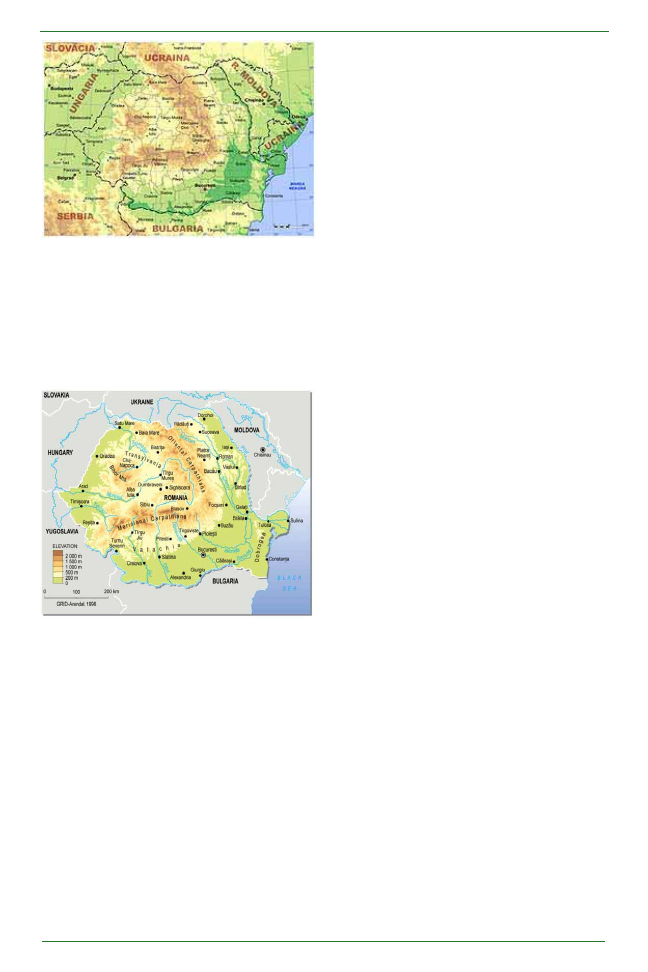
1 6
Plant Science Bulletin 56(1) 2010
Figure 1. Political Boundaries
Figure 2. Physical Geography
Peak (2,544 m ) is the highest mountain. The
Transylvanian mountains are drained by the
Mures River (Fig. 2). The Romanian population
of 22 million is found chiefly in the coastal
plains, and valleys between the mountains.
Bucharest, the capital, contains almost 2
million citizens in the greater area.
Owing to its distance from the open Atlantic
Ocean and position on the southeastern
portion of the European continent next to the
Black Sea and close to the eastern
Mediterranean, Romania has a climate that is
transitional between temperate and continental
climates with four distinct seasons. The
average annual temperature is 11°C (52°F) in
the south whereas it is 8 °C (46 °F) in the north.
The extreme recorded temperatures range
from 44.5 °C (112.1 °F) in Ion Sion (1951) and
“38.5 °C (“37 °F) in Bod (1942). Spring is
pleasant (cool nights and warm days).
Summers are generally very warm. Autumn is
dry and cool. Winters can be very cold in the
highest mountains, where some areas of
permafrost occur on the highest peaks. The
winter snows create a large skiing tourism
industry. Precipitation is average with over
750 mm (30 in) per year only on the highest
western mountains. In the south-central parts
around Bucharest, the level of precipitation
drops lower (around 600 mm) while in the
Danube Delta, rainfall levels are much lower
(around 370 mm).
Conservation of Biological Resources
Romania contains a high percentage of
minimally impacted natural ecosystems (47%
of its terrestrial space). Romania’s temperate
forests, historically considered important for
watershed conservation, have been
conserved, leaving Romania with one of the
largest undisturbed forest systems in Europe.
The botanical resources of the undisturbed
forests are of great value in studying European
forest systems. There are also almost 400
species of mammals (including 60% of brown
bears and 40% of wolves of Europe and the
Carpathian chamois), birds, reptiles and
amphibians as well as the important and
numerous plant species discussed below.
A critical problem of Romanian environmental
governance is that illegal logging is occurring
at an alarming rate to decimate these forests.
Protected areas in Romania contains almost
10,000 km
2
(3,900 sq mi) (almost 5% of the
total terrestrial area if Romania). Of these, the
Danube Delta Reserve Biosphere is the largest
and least damaged wetland complex in Europe,
covering a total area of 5,800 km
2
(2,200 sq mi).
A prodigious effort by a few Romanian biologists
occurred successfully so that the delta was
declared a Biosphere Reserve in September
1990, and a Ramsar site in May 1991, with over
50% the delta area placed on the World Heritage
List in late 1991. Within the Delta boundaries
is one of the most extensive marsh systems in
the world, much of it requiring restoration from
Central Planning’s conversion of the marsh
system to agriculture. There are two other
Romanian biosphere reserves in Retezat
National Park and in Rodna National Park.
Major concerns are soil erosion and
degradation in the delta and plains, air
pollutions from industries in the south, and
contamination by the Danube River flowing
through Germany, Austria, Slovakia, Hungary,
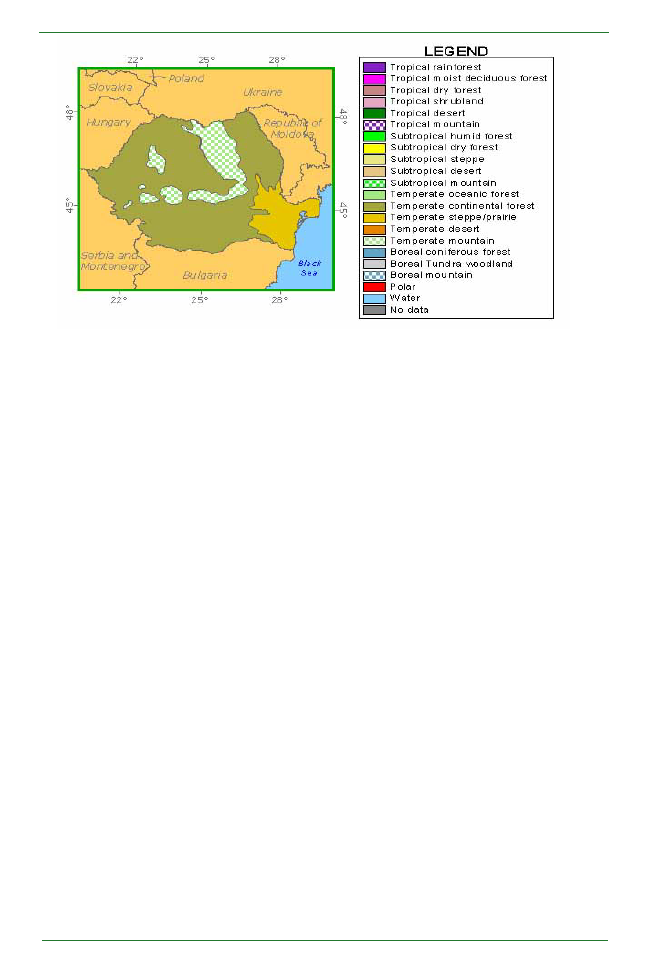
1 7
Plant Science Bulletin 56(1) 2010
.
Figure 3. Ecological Zones
Croatia, Serbia, and Bulgaria. The Danube
flows 2850 km (1771 miles), draining these
upstream nations and their pollution into
Romania and the Danube delta.
Romanian Protected areas
There are 427 nature reserves in Romania
plus
more than 600 marine and littoral protected
areas. The percent of terrestrial land in these
protected areas is 2.5% of Romania. There
are two wetlands declared Ramsar sites with
665 ha combined area. There are three
Biosphere reserves of 662 ha. The higher
plants in Romania inventoried in 2004
numbered 3,400 ( endangered and threatened
plant species discussed below), with 84
mammal species (17 threatened) and 257
breeding bird species (8 threatened), 22
reptiles, 19 amphibians, and 86 fish species.
Ecological Zones in Romania
Romania is characterized by a variety of
geological
relief forms (mountains, hills, hillocks, plains,
Black Sea coast) and a remarkable diversity of
vegetation (Sâvulescu, 1952-1976; Morariu,
1959; Bo_caiu et al., 1994; Ciocârlan, 2000;
Coldea et al., 2001). Romania’s natural
vegetation, which still covers half of the country
area, mainly consists of forests and
grasslands (about 70% of which forests are
28%) and partially of moor vegetation, rock
vegetation, water vegetation, etc.(Fig 3).
The main zones of natural and semi-natural
vegetation are correlated with latitude (steppe
zone, forest – steppe zone and oak tree forest
zone) and altitude levels (nemorose level,
boreal level, sub-alpine and alpine levels). It
has a significant diversity of plant species and
habitats, according to its five bio-geographical
zones: Continental, Pannonian, Alpine, Steppic
and Pontic (Black Sea).
Romanian Forests
The total forest area is 6,448 ha compared to
the total European forest area of 1,035,344 ha.
The original Romanian forest is estimated to
be 75% of the land area while the present forest
area comprises about 28%, mostly natural
forest with only 91 ha of forest plantation. The
total dry land area is 9,082 ha .The total land of
Romania is 23,839 ha which is about 10% of
Europe’s 2,301,873 ha. The shrub lands,
savanna, and grasslands are 1% of the area of
Romania, whereas cropland and crop/natural
vegetation mosaic are 69%, and urban and
built-up areas 0.9% . Wetlands and water bodies
( excluding the Black Sea waters)comprise
1%, which includes extensive rivers mostly in
the south and east.
Romania Wetlands and Utilization of Coastal
Resources
The length of coastline is 696 km with 6 percent
of population living within 100 km of the
coast.The Romanian area of territorial sea, up
to 12 nautical miles from shore,comprises
5,343 km
2
, with a claimed Exclusive Economic
Zone of18,046 km
2
of the Black Sea. Romania
has 11 Marine or Littoral Protected Areas. There

1 8
Plant Science Bulletin 56(1) 2010
are 6,470 km
2
of major wetlands of
International Importance of created as World
Heritage and Ramsar sites in 2000-1. 8500
fishermen in the inland and sea fisheries
produce 2389 metric tons marine fish, and
9,727 metric tons of freshwater fish. This has
been decreasing since 1980. There is not yet
a business enterprise of growing marine or
aquatic plants.
The Flora of Romania
There is an historical sequence of valuable
floral treatises written by professors of Botany
at various leading Romanian universities. The
first one “Prodromul florei române” was written
in 1879 by Prof. D. Brandza, followed in 1898 by
“Conspectul florei României” by Prof. D.
Grecescu. In 1923 and 1939, I. Prodan
published “Flora pentru determinarea si
descrierea plantelor ce cresc în România
”, and
in 1948 A. Borza published “Conspectus Florae
Romanae
”, in which there are included 3637
species (including hybrids) with their
subspecies, varieties and forms. The most
critical study, dealing with the vascular plants
contained in the territory of Romania, is “Flora
Republicii Populare Române
” in 13 volumes,
was published from 1952 to 1976, through a
joint effort of 25 botanists (published by the
Academy of the Popular Republic of Romania).
The volumes present about 3,400 species
grouped in 786 genera belonging to 126
families. Other recent publications include:
“Flora României” vol. I – II (Beldie,1977-1979),
“Flora ilustrat a României” vol. I – II
(Ciocârlan,1988-1990), “Flora ilustrat a
plantelor vasculare din estul României
” (Sârbu,
Stefan, Ivãnescu, and Mânzu, 2001),and “Lista
critic a plantelor vasculare din România
”
(Oprea,2005).
In 1994, “Lista Rosie a plantelor superioare din
România
” was completed, having been
elaborated by a group of specialists (Oltean et
al
., 1994) from the Biology Institute of the
Romanian Academy. The list is still being in
use today and includes a number of 1436 taxa
and infrataxa (1235 species and 203
subspecies) of threatened superior plants
(Pteridophytae, Gymnospermae and
Angiospermae
), which have priority to
protection and conservation. From these floras,
110 taxa are endemic for Romania (69 species
and 41 subspecies) and 79 taxa are
subendemic ones (65 species and 14
subspecies).
Romania has been a participant in the Global
Strategy for Plant Conservation (GSPC) and
European Strategy for Plant Conservation
(ESPC) respectively, for the period 2008-2014.
In these efforts there have appeared new
reference points for assessing and establishing
the priorities in plant protection and conservation.
One of the most important decisions for Romania
occurred at the sixth Conference of the Signatory
States of the Biological Diversity Convention
(CBD). This was the adoption in 2002 of the
Global Strategy for Plant Conservation (GSPC),
which reconsiders the importance of plants in
the global context of the conservation of
biodiversity.
Endemic and Endangered Plant Species of
Romania
Globally threatened (by evaluation and inclusion
in the Global Red List of IUCN [1997] Habitat
Directive) are 19 endemits (Armeria maritima
(Mill.) Willd. ssp. barcensis (Simonk.) P.Silva,
Astragalus peterfii
Jáv., Astragalus
pseudopurpureus
Gusul., Astragalus roemeri
Simonk., Campanula romanica Savul.,
Centaurea jankae
D. Brândz, Centaurea pontica
Prodan & Nyár., Delphinium simonkaianum
PawB., Draba dorneri Heuff., Draba haynaldii
Stur, Draba simonkaiana Jáv., Hesperis
oblongifolia
Schur, Lychnis nivalis Kit.,
Ornithogalum orthophyllum
Ten. ssp.
psammophilum
(Zahar.) Zahar., Pietrosia
levitomentosa
Nyár. ex Sennikov, Primula
wulfeniana
Schott ssp. baumgarteniana (Degen
& Moesz) Lüdi, Stipa crassiculmis P. Smirnov
ssp. heterotricha Dihoru & Roman, Stipa
danubialis
Dihoru & Roman, Tulipa hungarica
Borbás ssp. undulatifolia (Roman) Roman &
Beldie) and 2 subendemits (Larix decidua Mill.
ssp. carpatica (Domin) Šiman, Polygala supina
Schreb. ssp. hospita (Heuff.) McNeill). These
species may be found within the territory of
Romania in one or more locations (generally
found in nationally protected areas). All of these
species are included in EU’s Nature 2000
system of protected areas.
We will briefly discuss a few of these plants.
Extremely rare and threatened with extinction,
but still being considered part of the Romanian
flora are the following: Astragalus
pseudopurpureus
Gusul., Campanula
romanica
Svul., Centaurea jankae D. Brândz,

1 9
Plant Science Bulletin 56(1) 2010
Figure 4. Astragalus pseudopurpureus
Figure 5 Munticelul Natural Reserve
Figure 6. Campanula romanica
Figure 7
Cantaurea jankae
Centaurea pontica
Prodan & Nyár., and
Pietrosia
levitomentosa Nyár. ex Sennikov.
Astragalus pseudopurpureus
(Fam. Fabaceae)
is a globally threatened endemic taxon (Fig. 4).
It is a hemicryptophyte perennial species 10-
40 cm in height and with delicate purplish-blue
flowers which could be found in the Cheile
sugãului – Munticelul Natural Reserve (locus
classicus), a protected area (90 ha) of national
interest, category IV of IUCN (Fig. 5). The
thermophilous calcareous substratum and the
presence of the petrifying springs favored the
development of a rich and diverse flora,
predominantly chasmophilous. The site value
and uniqueness are given by not only the
richness of species (529) and the endemits or
subendemits (29) found in various grades of
vulnerability, but also the presence of seven
different types of habitats, among which two
are top priority for conservation (Habitat
Directive: 7220* - Petrifying springs with
travertine forming and 8240* - Calcareous
detritus and slabs).
Campanula romanica
(Fam.
Campanulaceae), a perennial vascular plant,
which is globally threatened, contains a
xerophyte saxicole with a rhizome and displays
blue flowers grouped in panicled
inflorescences. This species is endemic in
Romania, being vulnerable and rare (Fig. 6).
One could find it as an element of rock
vegetation only in the south-east of Romania,
in the region called Dobrogea. The continental
climate with steppic influences and the
predominantly calcareous substratum with
superficial soil favor the development of
significant populations. Even if it is cited in the
older literature as having been found in 29
sites, the species has been found in the last
five years only in 11 sites. Well-defined and
constant size populations have been present
in some protected areas as the Macin
Mountains National Park, the Alah Bair Hill
Natural Reserve, the Agighiol Geological
Reserve,and the Cheia Jurassic Reefs Natural
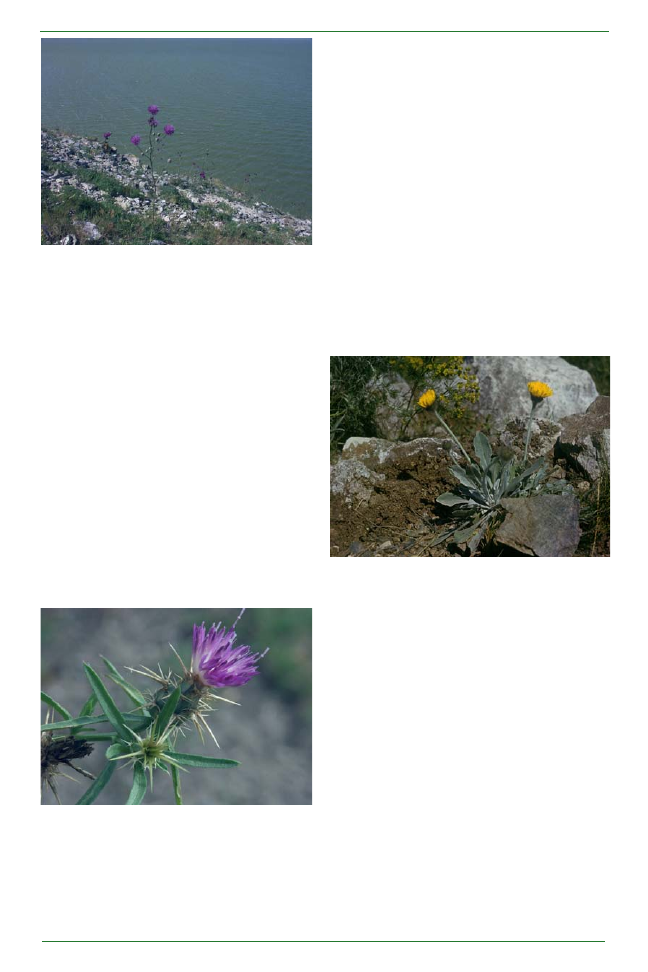
2 0
Plant Science Bulletin 56(1) 2010
Figure 8. Centaurea jankae
Figure 9. Centaurea pontica
Figure 10. Pietrosia levitomentosa
Reserve.
Centaurea jankae
(Fam. Asteraceae), a
globally threatened taxon, is endemic, and is
rare and threatened in Romania. This species
could be found in the structure of stony xerophile
grasslands in Dobrogea (Fig. 7, Fig. 8). The
calcareous substratum, the superficial and
stony soil and the extreme continental climate
characterizes this type of dry grasslands.
Centaurea jankae
is a perennial xerophyte
with a long rhizome, a simple or branched
stem of about 30-120 cm in length, large
anthodes, red flowers and pinnately-parted
leaves. It is very rare in Romania. Even if the
specialty literature suggests it as being present
in 6 locations, the reconfirmations during the
past five years have located it in only three sites
where it grows on the dry and stony slopes.
Two of them are natural reserves: Dolosman
Hill & Dolosman Cape and Dumbrãveni Forest.
Centaurea pontica
(Fam. Asteraceae), an
endemictaxon for Romania, is very rare and
has been evaluated as globally threatened. It
grows in stabilized (fixed) coastal dune
grasslands, on the river and sea sands in the
Danube Delta and in the company of arenicola
plants (Fig. 9). It is a biennial vascular plant, with
a strong tap root, a straight and branched
angular stem about 80-100 cm in length, a stalk
with inferior and middle leaves, pinnately-cleft
and sessile. The anthodes are abundant, the
flowers with a pale purple corolla, and the
achenes have no papus. The specialty literature
indicated its presence in two sites, situated
inside the Danube Delta Biosphere Reserve
(Sahalin-Ztoane Zone and East Sulina Sands).
These data have been reconfirmed by recent
research, which aimed at identification of the
most important sites for plant protection and
conservation in Romania.
Pietrosia levitomentosa
(Fam. Asteraceae) is a
Carpathian endemit, a strictly protected and
globally threatened species in Romania (Fig.
10). It is one of the plant species with the
smallest areas in the world. In Romania it
grows only in the “Pietrosul Brostenilor – Bogolin”
Natural Reserve beyond the forest limits. The
site is very important because it represents the
only place on Earth where the species Pitrosia
levitomentosa
exists. It is localized in the
subalpine level (1600-1780 m altitude) on
porphyroid-schists with a high concentration in
potassium, on slopes with an inclination of 30°-
80° and southeastern exposure where the soil
is acid (pH = 4.3), the multiannual average of
temperatures is of 2°-3° C, and the rainfall
average is of 926 mm. Pietrosia levitomentosa
is threatened with extinction because it presents
a small number of individuals, which do not
appear to produce viable seeds. This species
is a perennial plant, with dense pubescent
leaves and large anthodes with yellow flowers,
which form offsets, but whose spreading (in the
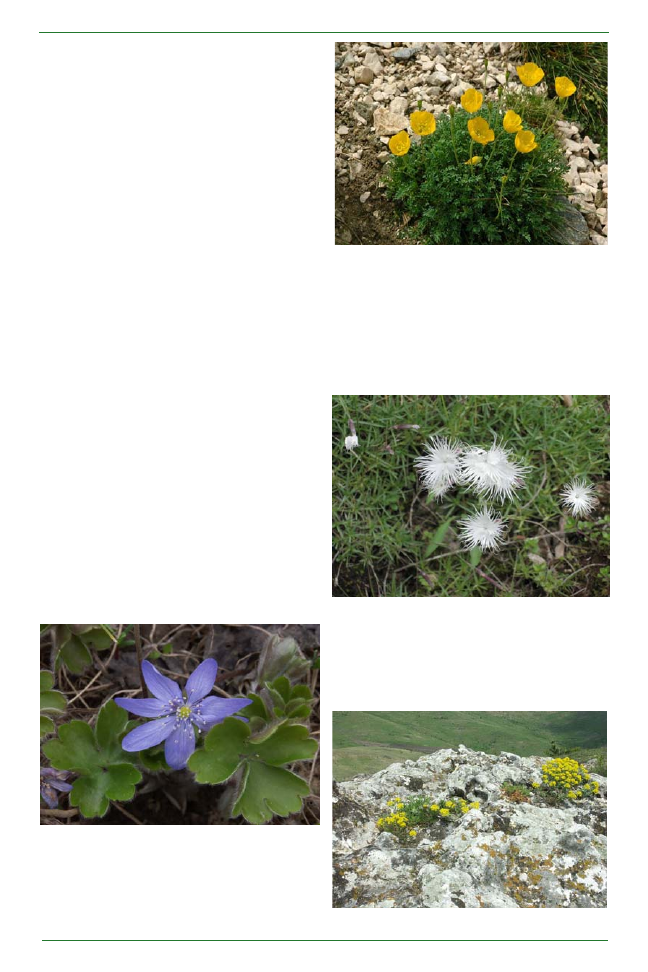
2 1
Plant Science Bulletin 56(1) 2010
Figure 11. Hepatica transsilvanica Fuss.
Figure 12. Papaver alpinum L. ssp. corona-
sancti-stephani
(Zapal.)
Figure 13. Dianthus spiculifolius Schur.
Figure 14. Dovrogea region
sense of increasing the number of individuals)
is limited by the ecological conditions.
Once Romania has entered the European
Union, it is scheduled to put into operation the
EU environment legislation, which regulates
flora and vegetation conservation. The Habitats
Directive of Nature 2000 stipulates that one of
the requirements is extending the system of
protected areas in EU to the new member
states (of which Romania is a new member).
In support of this, an identification program of
the most important areas of plant protection
and conservation in Romania (Important Plant
Areas – IPA) was carried out during 2002-
2004. On the basis of this two-year study, 276
sites were selected as candidates to the Nature
2000 European Network (Sârbu et al., 2007).
Thus, the IPAs are conceived as key sites, as
focal points for “in situ” conservation of
threatened species and habitats, and of floristic
concentrations of great botanical value,
essential for global, European and national
conservation of the dowry of vegetation diversity.
Fortunately, in Romania there still are areas of
extremely high botanical value, which should
be carefully preserved and maintained at their
existing level of nature to have maximum value.
In the mountainous region, the natural reserves
with endemits (Dianthus callizonus Schott &
Kotschy, Hepatica transsilvanica Fuss,
Papaver alpinum
L. ssp. corona-sancti-
stephani
(Zapal.) Borza, Pedicularis
baumgartenii
Simok) and the threatened
subendemits (Dianthus spiculifolius Schur,
Dianthus
tenuifolius Schur, Heracleum
carpaticum
Parcius, Onobrychis montana DC.
ssp. transsilvanica (Simonk.) Jáv. etc.) should
be noted (Fig., 11, Fig. 12, Fig. 13).
A very important region in Romania in terms of
extraordinary floristic richness is Dobrogea.
One can find here natural reserves and not only
over 50% of the endemits and subendemits of
Romania (Agropyron brandzae Pancu &
Solacolu, Alyssum caliacrae Nyár.,
Chamaecytisus
jankae (Velen.) Rothm., Iris
brandzae
Prodan, Linum pallasianum Schult.

2 2
Plant Science Bulletin 56(1) 2010
ssp. borzeanum (Nyár.) Petrova, Serratula
bulgarica
Acht. & Stoj. etc.) (Fig. 14).
The botanical assessments made during the
last decade clearly pointed out the driving
factors for the continuous degradation of these
extremely high value areas: 1.) The increasing
anthropogenic pressure; 2.) The lack of an
adequate environmental management; and
3.) Potentially climate change.
Present Botanical Research in Romania
Assessment and scientific research on
Romania’s natural botanical resources and
the identification of threatening factors
associated with different types of habitats at
the present stage of development of Romania
represent compulsory prerequisites of the
conservation and sustainability of plant
diversity.
Botanical research (morpho-anatomical and
reproduction, physiology, genetics, floristics,
phyto-sociology, etc.) is being carried out in
Romania both at the Universities’ disciplinary
departments (of which there are about 50
botany departments in Universities) and the
Romanian Research Institutions (about 30).
Among these, the most outstanding
universities include the University of Bucurest,
Babes-Bolyai University in Cluj-Napoca, the
University of Craiova, Alexandru Ioan Cuza
University in Iasi, the University of Medicine
and Pharmacy in Târgu Mures, Vasile Goldis
Western University in Arad, Ovidius University
in Constanca, Dunarea de Jos University in
Galaci all of which have significant botanical
research potential. The outstanding Research
Institutes are the National Institute for Biological
Sciences Research & Development, the
Biology Institutes of Romanian Academy in
Bucurest and in Cluj and, the Forest Research
and Management Institute.
The Future of Botany in Romania
In 2009-10 Romania is carrying out important
assignments regarding the assessment,
monitoring and conserving “in situ” and “ex
situ” vegetation diversity. The “Red List of
Romania” issuance is being implemented,
followed by the “Red Book of Romania”. At the
same time, an inventory of plant diversity and
a national data base are being assembled.
Romanian Implementation of the European
Union three laws of environmental problems
(Bird Directive, Habitat Directive and Water
Framework Directive) is now underway as is
finalization of the “Nature 2000 Site List”. All
these imply continuous efforts for developing
the human capabilities and government policies
necessary for the process of assessment,
scientific documentation and plant diversity
conservation. A new generation of plant
scientists is being trained to supply these
botanical efforts.
Literature Cited
BELDIE Al., 1977-1979. Flora României. Determinator
ilustrat al plantelor vasculare
(I, II), Edit. Acad. R.S.
România, Bucuresti.
BORZA Al., 1947-1949. Conspectus Florae Romaniae
Regionumque Affinium
, Tipogr. “Cartea Româneasc,
Cluj.
BO^CAIU N., COLDEA G. & HOREANU C. 1994. Lista
Rosie a plantelor vasculare disprute, periclitate,
vulnerabile si rare din flora României. Ocrot. Nat. 38(1):
45-56
BRANDZA D. 1879-1883. Prodromul Flore- române
sam enumeraciunea plantelor pn ast-di cunoscute în
Moldova si Valachia. Bucuresci: Tipografia Academie-
Române. /Pp. i-lxx, 1-128 in 1879; pp. i-vi, lxxi-lxxxiv,
129-568 in 1883/.
BRANDZA D. 1884. Vegetaciunea Dobrogei, Relaciune
presentat Academiei Române. Analele Acad. Române,
ser. 2, Secc. 2, 4: 405-448 + 2 Pl.
BRANDZA D. 1898. Flora Dobrogei. /The Flora of
Dobrogea/. Edicie îngrijit de Sabba Stefnescu.
Bucuresci: Inst. Arte Grafice “Carol Göbl”. i-xii, 1-490
+ 1 Pl. + errata.
CHIFU Toader, MÂNZU Ciprian & ZAMFIRESCU Oana.
2006. Flora & vegetacia Moldovei (România) I. Flora.
Iasi: Edit. Univ. Alexandru Ioan Cuza, 367 pp. + 2 Pl.
color + /1/ Addeanda et Corrigenda.
CHIFU Toader, MÂNZU Ciprian & ZAMFIRESCU Oana.
2006. Flora & vegetacia Moldovei (România) II.
Vegetacia. Iasi: Edit. Univ. Alexandru Ioan Cuza, 698
pp.
CIOCÂRLAN V. 1988-1990. Flora ilustrat a României:
vol. I-II, Edit. Ceres, Bucuresti.
CIOCÂRLAN V. & COSTEA M. 1997. Flora Rezervaciei
botanice Dealul Alah Bair (jud. Constanca). Acta Bot.
Horti bucurest. /1995-1996/: 97-104.
CIOCÂRLAN V. 1994. Completri la flora României.
Stud. Cercet. Biol., Biol. Veg. 46(2): 113-116.
CIOCÂRLAN V. 1994. Flora Deltei Dunrii. Bucuresti:
Edit. Ceres, 115 pp. + xii pl.
CIOCÂRLAN V., 2000. Flora ilustrat a României.
Pteridophyta et Spermatophyta, Edit. Ceres, Bucuresti.
CIOCÂRLAN Vasile. 2000. Flora ilustrat a României -
Pteridophyta et Spermatophyta. Edicia a doua revzut
si adugit. Bucuresti: Edit. Ceres, 1138 pp. + 1 /
Addenda/. ISBN 973-40-0495-6.
COLDEA Gheorghe, NEGREAN Gavril, SÂRBU Ion &
SÂRBU Anca. 2001. Ghid pentru identificarea si
inventarierea pajistilor seminaturale din România.

2 3
Plant Science Bulletin 56(1) 2010
Bucuresti Edit. alo. 58 pp.
DONIÞÃ N., IVAN D. COLDEA G., SANDA V.,
POPESCU A., CHIFU T., MITITELU D. & PAUCÃ-
COMÃNESCU M. 1992. Vegetaþia României.
Bucureºti: Edit. Tehnicã Agricolã.
DONITA, N., IVAN D. COLDEA G., SANDA V.,
POPESCU A., CHIFU T., MITITELU D. & PAUC-
COMNESCU M. 1992. Vegetacia României. Bucuresti:
Edit. Tehnic Agricol.
DONITA, N., POPESCU A., PAUC-COMNESCU M.,
MIHILESCU Simona & BIRIs Iovu-Adrian. 2005.
Habitatele din România. Bucuresti: Edit. Tahnic Silvic,
496 pp., ISBN 973-96001-4-X.
GRECESCU D. 1898. Conspectul Florei României.
Bucuresti: Tipografia “Dreptatea”. i-xvi, 1-836 pp.
MORARIU I. 1965. Botanic general sisistematic cu
nociuni de geobotanic. Ed. a II-a, Edit. Agro-Silvic,
Bucure_ti.
OLTEAN M., NEGREAN G., POPESCU A., ROMAN N.,
DIHORU G., SANDA V. & MIHILESCU S. 1994. Lista
rosie a plantelor superioare din România. In: M.
OLTEAN (coord.), Studii, sinteze, documentacii de
ecologie, Acad. Român, Institutul de Biologie, Nr. 1:
1-52.
OPREA A. 2005. Lista critic a plantelor vasculare din
România. Iasi: Edit. Univ. A. I. Cuza, ISBN 973-703-
112-1, 668 pp.
PAUC M. Ana & ROMAN Stefana. 1959. Flora alpin
si montan (îndrumtor botanic). Bucuresti: Edit.
stiincific, 308 pp. /incl. 265 fig. alb-negru / + erata/.
PRODAN I. 1934-1938. Conspectul Florei Dobrogei.
Bul. Acad. Înalte Stud. Agron. Cluj. 5(1): 175-342.
1935 /p. I/; 6: 204-161 + xlvi pl., 1936, /p. II/; 7: 16-102,
1938, (p.III). Et sep. 1-170, 1-57 + 46 pl., 1-96.
PRODAN I. 1939. Flora pentru determinarea si
descrierea plantelor ce cresc în România. Ed. II. Cluj:
“Cartea Româneasc”. 1 (p. 1), (i-cix + 1-624 pp.); 1
(p. 2) (625-1278 pp.). 2 (1-713 pp.) + Addenda (1 &
2): 1-31.
PRODAN I., 1939. Flora pentru determinarea si
descrierea plantelor ce cresc în România, Tipogr.
“Cartea Româneasc”, Cluj.
SÂRBU I. & CHIFU T. 2003. Lista Rosie a plantelor
vasculare din Moldova. Memoriile Secc. Sti., Ser. IV,
Tom XXIV, 2001, Academia Român. Pp. 131-151.
SÂRBU I., STEFAN N., IVNESCU Lcrmioara, MÂNZU
C., 2001. Flora ilustrat a plantelor vasculare din Estul
României. Determinator (I, II), Edit. Univ. “Al. I. Cuza”,
Iasi.
SVULESCU T. (ed.), 1952-1976. Flora R.P. Române
– R.S. România (I-XIII), Edit. Acad. R.P. Române (R.S.
România), Bucuresti.
3
Author for correspondence (email:
leed@fiu.edu
)
Received: 7 January, 2010
Accepted for publication: 18 January, 2010
Using Bottles to Study Shade
Responses
of Seedlings and Other Plants
David W. Lee
1,2,3
Eric Von Wettberg
1,2
1,3
Department of Biological Sciences, Florida
International University, Miami, FL 33199
2
Fairchild Tropical Botanic Garden, 10901 Old
Cutler Road, Coral Gables, FL 33156
ABSTRACT
We briefly review the nature of light and its
effects on plants, and then describe an
inexpensive experimental system for studying
the effects of shade, specifically the
contributions of reduced intensity (“quantity”)
and the altered spectral distribution of foliage
shade (“quantity”) on the development of
seedlings and other plants. This system has
been devised to be safe to construct,
inexpensive in its use of readily available
materials, and appropriate for a range of student
grade levels, from ~grade six to university
courses in botany. We conclude by suggesting
a range of experiments this system will allow.
An advantage of this system is that it promotes
the study of the responses of a large range of
plants, most completely unstudied for these
responses.
Key words:
spectral quality, R:FR, phytochrome,
plasticity, development
Being fixed in place, plants are plastic in their
response to environmental cues, particularly
shade. Plants use two types of light cues, both
quantitative and qualitative, as well as the
duration of light exposure, in these responses.
Here we describe a simple experimental
system that can be used to study such plant
responses to shade. It uses easily obtained 2
liter soda bottles for the shade enclosures and
1 gallon plastic milk bottles as the containers
in which to grow the plants, optimally seedlings.
These shade enclosures use films
manufactured by the 3M Corporation to reduce
light intensity and to mimic the altered light
quality produced by foliage growing above and
around plants.
The Nature of Light. Light is that portion of the
spectrum of electromagnetic radiation that is
visible to humans, the colors of blue-violet to
dark red. This visible spectrum lies between
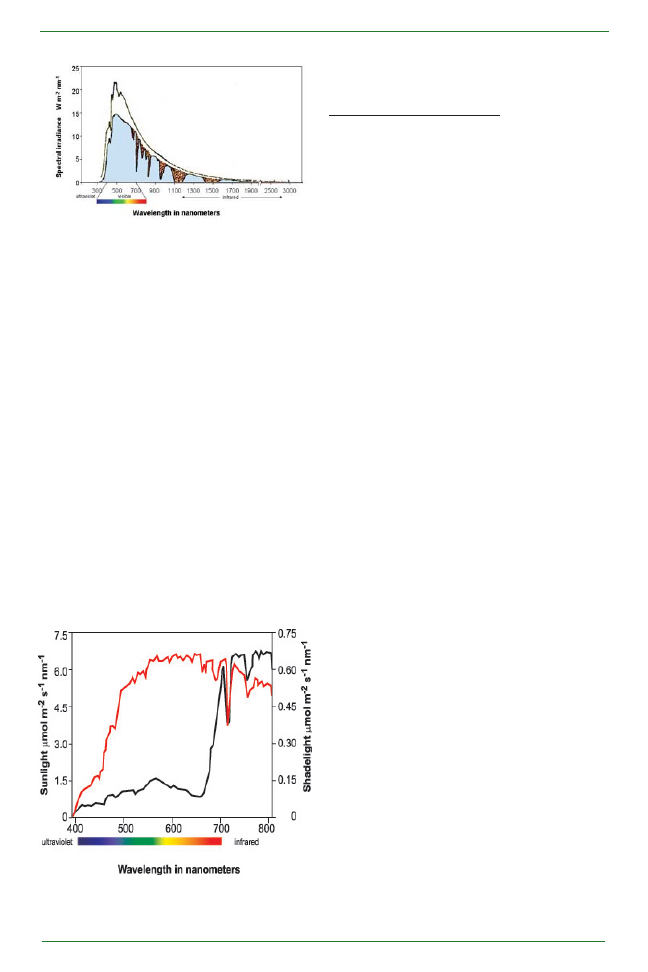
2 4
Plant Science Bulletin 56(1) 2010
Figure 1. Spectral distribution of electromagnetic
radiation above the atmosphere (top curve) and at
sea level, as energy, and showing the visible part of
that spectrum.
Figure 2. Spectral distribution of radiation above a
tropical deciduous forest site in India, immediately
after the rains. Note the different scales of the
sunlight and shadelight, and the units in photons.
the wavelengths of 400 to 700 nm and
represents about half of the energy of that
spectrum arriving at the earth’s surface from
the sun. Gases in the atmosphere absorb
bands of radiation, particularly in the infra-red
region, giving the solar spectrum a ragged
appearance (Fig. 1).
Electromagnetic radiation can be described
as both a wave and a particle, or photon. The
solar spectrum in its entire range is defined in
Fig. 1 as the energy of a wave, measured as
watts/m
2
/nm. It is useful to measure this
radiation as particles when we consider its
photobiological action on plants, as in
photosynthesis or developmental responses.
The units we use in such measurements, as
seen in these spectra of light above a forest
canopy and light beneath it (Fig. 2), are in
particles (photons) per unit area (meter square),
per unit time (second), and per wavelength
interval (nanometer, nm): μmol/m
2
/s/nm.
Light and Plant Responses. Being creatures of
light, relying on it for the energy and control of
development and function, plants respond to
light in a variety of ways (Raven, Evert & Eichorn,
2005; Taisz & Zeiger, 2006). For photosynthesis
and growth, plants absorb in the range of 400-
700 nm, the region of the spectrum that is
absorbed by the photosynthetic chlorophyll
pigments. Plants also have blue wavelength
receptors that are used to control the effects of
radiation on the direction of growth, or
phototropism. This wavelength is also important
in controlling the opening and closing of the
stomata, the “lips” of the plant, that regulate the
diffusion of gases in and out of the leaf. All of
these responses are basically quantitative, as
the pigments are sensitive to the amounts of
radiation absorbed, and blue wavelengths are
strongly correlated with the visible spectrum
under natural light conditions.
In addition, plants have an elegant system to
measure the quality of light, which is sensitive
to shifts in the spectral distribution of different
wavelengths, or the quality. Canopies mostly
screen light in the visible portions of the
spectrum (Fig. 2), but do not reduce the
absorption of those portions just beyond our
visual sensitivity, or the far-red region (the
shortest wavelengths of infra-red). This change
in quality is demonstrated by the change in the
ratio of photons received at around 660 nm (red)
compared to around 730 nm (far-red). The ratio
of the two, or R:FR, varies from ~1.05-1.25 in
sunlight (with the value increasing in greater
humidity) compared to ~0.25 in canopy shade.
A pigment system, phytochrome, is sensitive to
this ratio.
In plant tissues exposed to light, light-stable
phytochromes are generated in a biologically-
inactive red light absorbing form, Pr. Photons of
red light shift phytochromes into a far-red light
absorbing form, Pfr, which is physiologically
active (suppressing stem elongation, for
example) unless a photon of far-red light shifts
it back into the inactive Pr form. The balance
between the two forms matches the red:far-red
light experienced by a plant. Since this ratio is
influenced by light passing through vegetation
or reflected by green plant organs, phytochrome
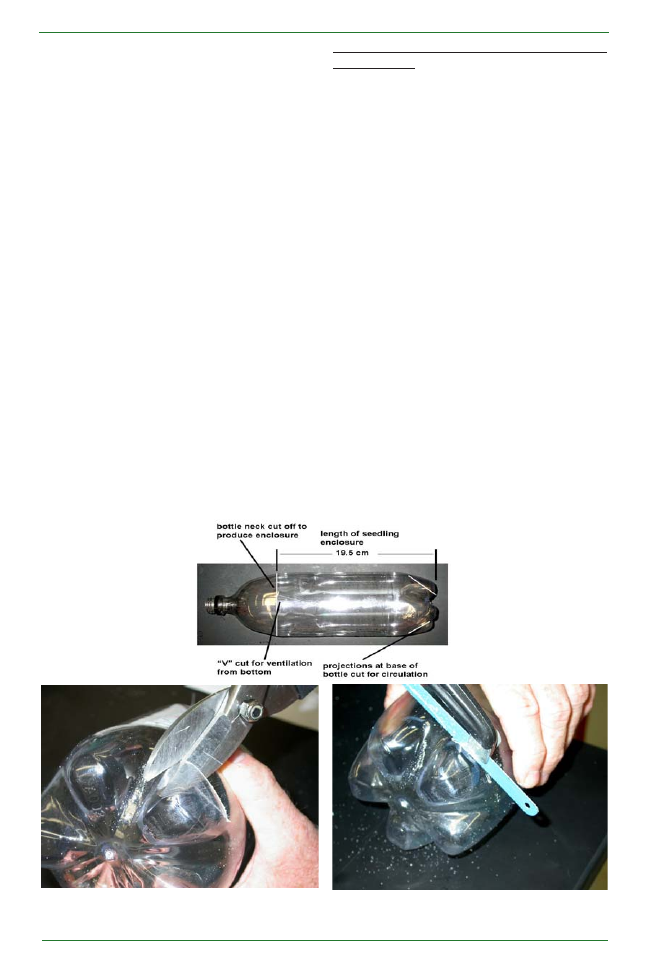
2 5
Plant Science Bulletin 56(1) 2010
is a sensor that detects the presence of other
nearby plants—or competitors for light.
Plants respond to shade, both low light intensity
and quality, with a syndrome of responses that
avoids shading. The suite of responses varies
among species and life stages. The general
shade avoidance response is one of etiolation,
with a taller and thinner appearance, no
branches, fewer and smaller leaves, and less
allocation to leaves and roots. Other changes
in response to shade include the length of the
petiole, the distance between successive
leaves, earlier flowering, and the amounts and
composition of pigments. Plants vary in their
response to reduced light intensity (less
“quantity”) in comparison to changes in spectral
distribution (differences in “quality”). Plants
also vary their responses with regard to the
direction from which the light arrives, as the
difference between diffuse overhead light
compared to light from the side that is reflected
from adjacent plants. A challenge, met by the
simple experimental system described here,
is to distinguish between the effects of “quantity”
versus “quality”, since both components are
present in different shade conditions.
Figure 3. Illustrations of the construction of the bottle shade enclosures. Top, the positions of cuts and
the dimensions of the shade enclosure. Bottom, illustrations of the use of safe tools to prepare the
enclosures.
Using Shade Films to Construct Shade
Environments. The simplest way to alter light
quantity and quality is to employ commercially
available shade films to alter the passage of
sunlight, which has abundant portions of visible
and far-red radiation. Such films are
commercially available, and 3M (Minneapolis,
MN) produces the greatest quantity both for
automobile and building windows. Films with
a thin coating of metal absorb all wavelengths
about equally, and thus allow a diminished
amount of sunlight (a quantitative change in
light) to pass with no alteration in spectral
quality. Dye-impregnated films contain
molecules that preferentially absorb visible
wavelengths of radiation and let more of the far-
red portion to pass through the filter. Such films
reduce the R:FR in a manner similar to a
vegetation canopy (qualitative changes in light).
From a survey of shade film products, we have
found that films reducing transmission by about
80%, or allowing about 20% of the solar
radiation in the visible spectrum to reach the
plants. In full sunlight, which may vary from
~1300 to 1800 μmol m
-2
s
-1
in the region of 400-
700 nm, this shading reduces intensity to 260-
360 μmol m
-2
s
-1
, adequate for growth of virtually
any seedling. A simple experiment of a well-lit
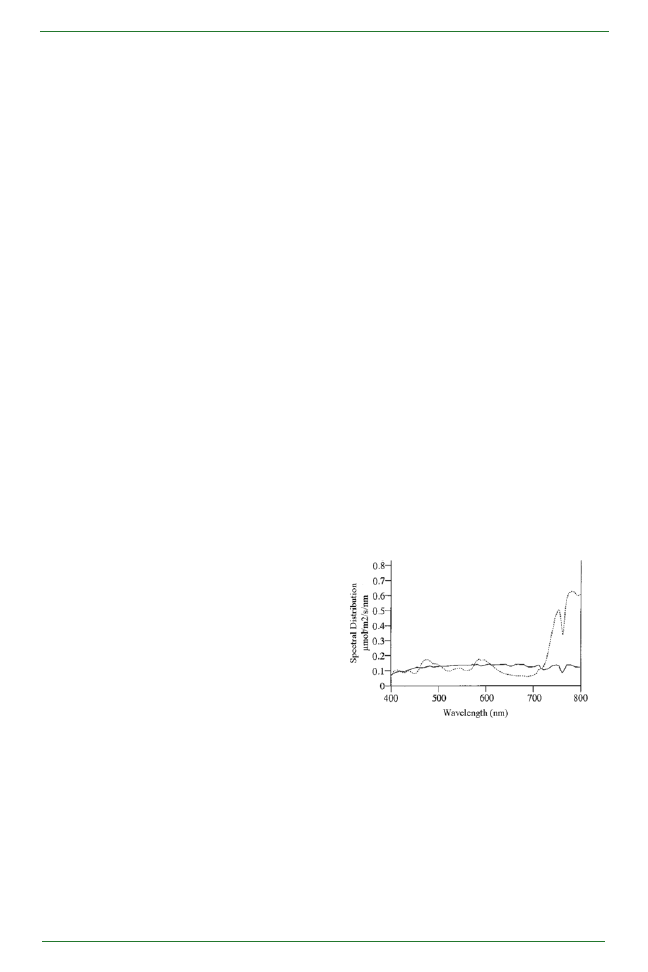
2 6
Plant Science Bulletin 56(1) 2010
Figure 4. Spectral distribution of radiation within
the neutral shade enclosures (solid line) compared
to the low R:FR shade enclosures (dotted line: Lee
et al., 1995).
control, and low and high R:FR treatments in
moderate shade will determine how plants
respond to shade. Additional screening (dark
window screening further reduces light by
~50%), can produce four shade environments:
of moderate shade with high or low R:FR, and
deep shade with high or low R:FR. The light
sources chosen to produce these effects are
also important. Fluorescent bulbs produce
little FR radiation, which explains their greater
efficiency, and they cannot be filtered to produce
a low R:FR condition. High intensity tungsten
bulbs are effective but produce a R:FR lower
than direct sunlight. Thus, the shade
enclosures described in this article work best
with exposure to direct sunlight, such as south-
facing windows in a school room or, better yet,
a greenhouse bench.
Materials and Methods: Using plastic bottles
to Produce Shade Environments.
Clear plastic 2 liter soda bottle make excellent
shade enclosures. These are very easy to
obtain, allow a high percentage of light
penetration (over 95%), and are relatively easy
to cut to produce the enclosures. After an initial
cut with an inexpensive metal saw blade, the
sides of the bottles are easily cut with heavy
scissors or light metal shears. The bottle
should be cut laterally at the point where it
begins to narrow towards its mouth (Fig. 3).
The raised bases of the bottle can be cut to
provide some vertical ventilation, allowing the
rising warmer air to move out of the enclosure.
The previous technique avoids the use of
potentially hazardous sharp blades. We have
found that the best procedure is to cut into the
base of those swellings with a light metal hack
saw, which is easy to do. We then use the
metal shears or short-bladed heavy duty
scissors to cut through the cuts and along the
raised bases, and then remove them by cutting
towards the middle of the base of the bottle to
sever them. Each enclosure should be 19.5
cm long from the open base to the top. After the
film is affixed to the bottle, “V” shaped slits can
be cut on two sides of the base, 3 cm deep,
after the film is affixed to the bottle, to provide
some ventilation.
Similarly, 1-gallon plastic milk cartons provide
the soil container and base of the shade
enclosure. These containers need to be cut,
as above, 9 cm from the bottom of the carton.
After cutting, the interior of the containers need
to be spray-painted with a flat black enamel to
minimize any light reflection into the growing
environment.
Using clear tape, affix a rectangular piece of
shade film, 18 x 34 cm, from around the base of
the clear plastic enclosure, to just beneath its
top. Shading at the top is added by loosely
taping a square piece of film, 18 x 18 cm, from
its corners to the sides of the enclosure. At the
bottom of the enclosure, with film attached,
gently cut two V notches approximately 3 cm
deep on opposite sides. When the experiment
is prepared, seedlings are planted in the middle
of the base, in potting soil that is approximately
5 cm deep. Then the shade enclosure is
pressed into the soil about 2 cm deep, providing
an opening at the tips of the V for ventilation. Two
conditions are important for the use of the
shade environments. First, the small openings
at the bottom and top provide ventilation and
prevent the build up of heat. Second, there is no
leakage of direct light onto the plants to alter the
amount and quality of radiation.
These enclosures are designed to be used with
two different shade films. Both films are
manufactured by 3M, and provide about 80%
shade (or prevent 20% of the sunlight passing
through the films, Fig. 4). The spectrally neutral
shade film has a metallic sheen to it and goes
by the product name of RE20. The reduced
R:FR film (at about 0.25) goes by the product
number of FXST20. We can provide pre-cut
pieces of both films in limited quantities, by
contacting the author for correspondence

2 7
Plant Science Bulletin 56(1) 2010
Figure 5. Plant diagram indicating the structures
that vary as seedlings grow under different
shade conditions. These features can be directly
measured with a metric ruler, or by weighing dried
plant organs.
through email. Also, it should be feasible to
obtain film samples from your local 3M Building
Products representative. Overall, the shade
enclosures reduce light intensity in the
photosynthetic range by 82%. With fairly bright
sunlight, it will be possible to further reduce the
light by another 50% (to 9%) by surrounding the
enclosures with black nylon window screen.
Results and Discussion: Experimenting with
Shade
With these simple shade enclosures, you can
study the influence of shade light (both quantity
and quality) on development of a variety of
plants. These include seed germination,
seedlings, small adult plants (as Wisconsin
Fast Plants or Arabidopsis), mosses and
liverworts, small ferns. For an example, we’ve
used the growth of seedlings of chickpea (Cicer
arietinum
) to demonstrate the effects of neutral
and reduced R:FR shade on the morphology
of the plant. We can think of shade responses
in general as a searching strategy for more
light energy, whereby the plant produces longer
and thinner stems, reduced leaf size and
reduced allocation to leaves and roots. In
general, we might expect to see a variety of
effects manifested by young plants growing in
different light conditions (Fig. 5).
These responses can be easily measured by
cutting up the seedlings into components (like
roots, stems and leaves), drying them, and
then weighing them on a balance. Leaf area
can be estimated by scanning them and using
Photoshop or ImageJ to estimate their area, or
by tracing the outlines on graph paper, or onto
paper and creating a relationship between
paper mass and area for calibration. All of the
length measurements can be made with a
metric ruler (a good way to teach about the
metric system, too). The degree of branching
can be determined by counting the number of
nodes in the branches and main stem, to
produce a ratio. Allocation to organs can be
estimated by cutting up the seedlings into
components (roots, stems and leaves), drying
them, and then weighing them with a balance.
In comparing the growth of seedlings (as by
measuring heights), it is important to soak the
seeds and germinate them a bit in moist
toweling before placing them in the soil. This
insures that the seedlings are at the same size
when placed in the enclosures. We have
attached photographs of the results of the
experiment with chickpea (Fig. 6). Clearly, leaf
size has been altered by reduced light, and
even further by reduction in R:FR. These
experiments could be performed by students
in middle and high school, and perhaps even
5
th
grade.
Other potential experiments. Shade responses
of plants, and plasticity in general, are topics of
fundamental importance and considerable
contemporary interest (Ballare, 2009; Ballare
& Scopel, 2007; Franklin, 2008; Lee et al., 1996;
Morgan and Smith, 1979; Novaplansky, 1991;
Schmitt et al. 1995; Smith and Whitelam, 1997;
Trewavas, 2009; von Wettberg and Schmitt,
2005; Weiner, 1986). Thus, these enclosures
could be used at the university level, from first
year courses in biology to advanced courses in
development, genetics, and plant ecology. We
outline some of these potential experiments in
the following paragraphs.
Vines are great study organisms for shade
responses. Most are heteroblastic; they have
markedly different morphologies, particularly
in leaf size and shape, at different
developmental stages. The shade enclosures
could be used to study leaf morphology as well
as internode length during early seedling
development. Morning glory (see Weiner, 1986)
and vining legumes (as peas) would be good
plants to examine. Seeds are easily obtained
and germinate at high rates. One can start by
growing single vines per chamber under varied
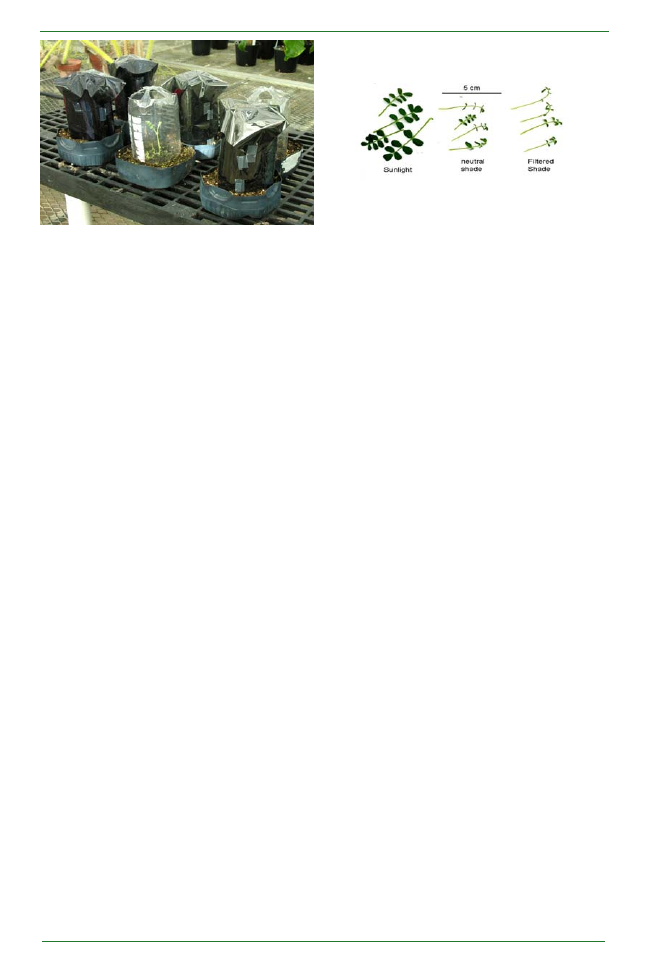
2 8
Plant Science Bulletin 56(1) 2010
Figure 6. Left, shade enclosures of growing chick pea seedlings. Right, differences in compound leaf
morphology in chick pea seedlings under different light conditions. Leaf size has been altered by
reduced light, and even further by reduction in R:FR.
light intensities and qualities. Vines will
respond differently to moderate light intensity
paired with high or low R:FR, and low light
intensity paired with high or low R:FR shading.
Students can develop hypotheses about
expectations of how plant traits (leaf size and
shape, stem length, petiole length, total
biomass, allocation to roots and shoots, etc.)
will respond, and test them.
Vine development can be studied at added
layers of complexity. Plants compete against
one another for light, as well as for soil
resources. In vines, the degree of competition
for light is easily varied by the use of stakes.
With a shared stake, two vines in the same
chamber compete, but with two separate
stakes competition for light is reduced.
Students can then hypothesize and test how
responses to competing vines change with
light quantity and quality. For example, do
vines without competitors under low red:far-
red light conditions have forms similar to those
competing for light? To add to the complexity
of soil competition, multiple growth chambers
can be planted with two seeds in each (or four
seeds and thinned to two to ensure at least two
seedlings survive). In half of the chambers,
divide the soil with a partition and plant so that
a seedling is present on each side of the
partition. One can then alter the staking in each
chamber, so that the two seedlings either have
separate stakes or share a stake. This creates
four experimental conditions: neither
belowground nor aboveground competition,
belowground competition only, aboveground
competition only, and no competition.
Hypotheses, observations and measurements
can focus on the effects of different sorts of
competition on plant traits.
These chambers can be used in similar way to
test other factors affecting seedling and plant
growth. Planting density affects plant form, and
small plants can be grown at different densities
in the shade enclosures, allowing additional
analysis of shade effects. These enclosures
could be used to distinguish between above
ground and below ground competition by
placing barriers in the soil to keep the root
systems separate. The enclosures could also
be modified to control the shading from different
directions, as shade from the side with opening
above, or shading only from above. Many forest
understory herbs are thought to elongate in
response to other plants in the understory, but
to not elongate much to overhead forest canopy
(Morgan and Smith, 1979; von Wettberg and
Schmitt, 2005). Students can test this
hypothesis with plants native to their own region.
These enclosures will also provide
opportunities for laboratory experiments in
genetics courses for majors, and advanced
courses in plant genetics. This requires plants
that are well-characterized genetically. Ideal for
these purposes is the mouse ear thale cress,
Arabidopsis
thaliana. It is small in size, grows
quickly, has its genome sequenced, and there
is a scientific infrastructure that makes available
a variety of well-characterized mutants. Seeds
are available online from The Arabidopsis
Information Resource Center (TAIR) at The
Ohio State University (
www.arabidopsis.org
).
Although Arabidopsis has a rosette growth
form, and thus does not allow the analysis of
height growth or internode length, the rosettes
vary in petiole elongation. How does change in
R:FR affect rosette width with and without
competition from other plants?

2 9
Plant Science Bulletin 56(1) 2010
Several genes control plant responses to
shade. Phytochrome is a protein with a
tetrapyrrole chromophore attached. In
Arabidosis
there are five types of phytochrome,
resulting from changes in the amino acid
sequence of the protein; these phytochromes
form a gene family. Phytochrome B is the
member most involved in shade avoidance.
Mutants without the gene for phytochrome B
(e.g. stock number CS6211) have longer than
normal hypocotyls, longer petioles, and they
flower earlier. Overexpression mutants (e.g.
CS8037) have shorter petioles and hypocotyls.
With both of these classes of mutants, the
effects vary with light treatment. Other mutants
are also available, as for other phytochrome
genes. There is a small overlap in function of
these five members, and mutants have been
instrumental in clarifying their roles. Advanced
experiments could utilize mutants of
Phytochrome A, an unusual member of the
family that degrades in light and has roles in
de-etiolation, and contrast its role to
Phytochrome B [see Smith and Whitelam
(1997) for details and further suggestions].
Mutants have been isolated in other plants
besides Arabidopsis, as for the Wisconsin
Fast Plant (a patented variety of Brassica rapa—
canola). Seeds of these mutants can be
obtained from
www.fastplants.org
or from
commercial biological supply companies.
Helping to Solve the Challenge of Making Plants
Interesting. Most students, at all ages, are less
interested in plants than they are in animals.
After all, we are animals. This is particularly
true for non-majors and the typical pre-med
student in a general biology course. However,
plasticity in response to an environmental
signal, as light, is a plant equivalent to animal
behavior (Trewavas, 2009). It takes a few days
to observe changes, but the responses can be
quite dramatic. Adding the influences of light
quantity and quality adds a dimension similar
to the social responses of people in a crowded
setting, where many will seek to keep some
personal space. Plant responses to shade are
partly a direct response to nearby plants
(because of the alteration of R:FR above, or
adjacent to, the affected plant) as when they are
crowded. Experiments with these shade
environments provide students with a plant
behavior that they might understand, and could
make plants more interesting to them. Finally,
the outcome of these responses of plants to
their neighbors affects the yields of our crops
when surrounded by weeds, and the structure
of forests—aspects of plant biology that are
important in today’s world.
LITERATURE CITED
Ballare, C. L. 2009. Illuminated behavior:
phytochrome as a key regulator of light foraging and
anti-herbivore defense. Plant, Cell and Environment
32: 713-725.
Ballare, C., and A. L. Scopel. 1997. Phytochrome
signaling in plant canopies. Testing its population-
level consequences using photoreceptor mutants of
Arabidopsis
. Functional Ecology 11: 441-450.
Franklin, K. A. 2008. Shade avoidance. New
Phytologist
179: 930-944.
Lee, D. W. 2007. Nature’s Palette. The Science of
Plant Color. University of Chicago Press, Chicago.
Lee, D. W., K. Baskaran, M. Mansor, H. Mohamad and
S. K. Yap. 1996. Light intensity and spectral quality
effects on Asian tropical rainforest tree seedling
development. Ecology 77: 568-580.
Morgan, D. C. and S. Smith. 1979. A systematic
relationship between phytochrome-controlled
development and species habitat, for plants grown
in simulated natural radiation. Planta 145: 253-258.
Novoplansky, A. 1991. Developmental responses of
Portulaca
seedlings to conflicting spectral signals.
Oecologia
88: 138-140.
Raven, P. H., R. F. Evert and S. E. Eichhorn. 2005. The
biology of plants, 7
th
edition. W. H. Freeman and
Company, New York. (p. 632-634)
Schmitt, J., A.C. McCormac and H. Smith. 1995. A test
of the adaptive plasticity hypothesis using transgenic
and mutant plants disabled in phytochrome-mediated
elongation responses to neighbors. The American
Naturalist
146: 937-953.
Smith, H. and G. C. Whitelam. 1997. The shade
avoidance syndrome: multiple responses mediated
by multiple phytochromes. Plant, Cell and Environment
20: 840-844.
Taiz, L, and E. Zeiger. 2006. Plant physiology, 4
th
edition. Sinauer and Associates, Sunderland, MA.
Trewavas, A. 2009. What is plant behavior? Plant,
Cell and Environment
32: 606-616.
Von Wettberg, E. and A. Schmitt. 2005. An
experimental separation of stem and leaf shade
avoidance responses in Impatiens capense.
American Journal of Botany
92: 868-874.

3 0
Plant Science Bulletin 56(1) 2010
Books Reviewed In this issue:
Developmental and Structural
Bryophyte Biology (second edition)
. Goffinet, Bernard and A. Jonathan Shaw - Robynn
Shannon.......................................................................................................................................................31
Conifer Reproductive Biology
. Williams, Claire G - Danillo D. Fernando......................................32
Manual of Leaf Architecture
. Ellis, Beth, Douglas C. Daly, Leo J. Hickey, Kirk R. Johnson, John
D. Mitchell, Peter Wilf, and Scott L. Wing- James Beville and Hongshan Wang..................................34
Ecological
Seedlings of Barro Colorado Island and the Neotropics.
Garwood, Nancy C - Suzanne
Koptur.........35
Economic Botany
If a Tree Falls: Rediscovering the Great American Chestnut.
Buege, Douglas J. - Douglas
Darnowski....................................................................................................................................................37
Picturing Plants: An Analytical History of Botanical Illustration.
Gill Saunders - Elizabeth J.
Farnsworth...................................................................................................................................................38
Paleobotanical
Paleobotany: The Biology and Evolution of Fossil Plants.
Second edition. Taylor, Thomas N.,
Taylor, Edith L., Krings, Michael. - Carole T. Gee.................................................................................39
Physiological
Plastid Biology
. Pyke, Kevin. - Carolyn Wetzel...........................................................................................40
Plant Biochemistry
, Caroline Bowsher, Martin Steer, and Alyson Tobin- Carolyn
Wetzel.......................41
Intracellular Signaling in Plants. Annual Plant Reviews, Volume 33.
Yang, Zhenbiao (ed) - Jane
G
e
i
s
l
e
r
-
Lee......................................................................................................................................................41
Introduction to Plant Biotechnology, 3
rd
ed.
Chawla, H.S. - Lawrence Davis...............................42
Systematic
A Guide to Florida Grasses
. Walter Kingsley Taylor. - Joanne Sharpe............................................44
The Illustrated Moss Flora of Antarctica.
Ochyra, Ryszard, Ronald I. Lewis Smith and Halina
Bednarek-Ochyra. - Douglas Darnowski..................................................................................................45
Pitcher Plants of the Old World (volumes I and II)
Stewart McPherson - Douglas
Darnowski............45
Plants of Bastar, Chhattisgarh.
Madhu Ramnath. - Rainer Bussmann..............................................46
Weiner, J. 1986. How competition for light and
nutrients affects size variability in Ipomoea
tricolor
populations. Ecology 67: 1425-1427
.
Acknowlegements
The authors thank Barry Tomlinson, Jack
Fisher and David Jones for assistance and
advice in this research. Maxwell Hubbard and
Bernard Koch provided helpful suggestions to
improve the clarity of presentation. The
Kampong of the National Tropical Botanical
Garden provided facilities for much of this
research.

3 1
Plant Science Bulletin 56(1) 2010
Bryophyte Biology (second edition).
Goffinet,
Bernard and A. Jonathan Shaw. 2009/ISBN
978-0-521-87225-6 (Hardback) 565 pp.
Cambridge University Press, The Edinburgh
Building, Cambridge CB2 8RU, UK
Now in its second edition, Bryophyte Biology
is a comprehensive reference work on all
aspects of the biology and ecology of these
“small but mighty” plants. But why the need for
such a work, on this relatively small group of
plants (at least compared to angiosperms!)?
The impression might be that this is just
another one of those books that is written only
for specialists on that group. Au contraire,
Bryophyte Biology
’s appeal and utility are to an
audience much broader than bryologists. The
role of bryophytes in the evolution of land plants
and their importance in ecological processes
will make this book valuable to anyone
interested in plant evolution or ecology. Though
suitable for use as a graduate-level text book,
it is written more as a broad reference work.
As is often the case with second editions, this
edition of Bryophyte Biology is a substantial
improvement over the first edition. It is nearly
100 pages longer, has more contributors, and
is overall broader in scope, as illustrated by the
chapter on the origin and phylogenetic
relationships of bryophytes in the first edition
being replaced by one on phylogenomics and
early land plant evolution in the second.
Half of the chapters are updates of chapters in
the first edition, some of which have been
greatly expanded. An example of this is the
chapter on the morphology, anatomy, and
classification of the Bryophyta, sixty percent
longer and with nearly two and a half times the
number of references of the comparable
chapter in the first edition. A few other chapters
treat similar subject matter as in the first edition,
but with different authorship and, in some
cases, a different focus. In some cases, topics
have been rearranged or consolidated. In
short, most of the topics covered in the first
edition are also found in the second. The two
first edition chapters that have been dropped
completely from the second edition are those
on chemical constituents and biochemistry
(first edition Chapter 5) and the global carbon
budget (first edition Chapter 11).
Some of the most exciting new material in this
edition includes the chapters on mosses as
model organisms (5, Cuming), biochemical
and molecular mechanisms of desiccation
tolerance (7, Oliver), and bryophyte species
and speciation (11, Shaw). Each of these
topics is part of a much larger area of current
interest in biology. The results of research on
model organisms are, by definition,
generalizable (at least to some degree), and it
is refreshing indeed to learn of moss species
worthy of joining Arabidopsis as standard-
bearers for the plant kingdom. Desiccation
tolerance in bryophytes is of interest not only
because, as early land plants, they give us
insights into how the first land plants probably
“figured out” how to live in a terrestrial
environment, but also because the unique
desiccation tolerance mechanisms in
bryophytes show us survival at the very edge of
life (vascular plants mostly avoid, rather than
truly tolerate, desiccation). By summarizing a
large volume of research on bryophyte species
and speciation, Shaw has made it accessible
for the countless discussions on species
concepts and speciation occurring in journals
and seminar rooms and everywhere else
evolutionary biologists interact. Also of special
note is the chapter on hornworts (3, Renzaglia
et al.
), because of the many changes in our
understanding of that group that have occurred
since the publication of the first edition, thanks
in large part to research by these authors.
My few criticisms of this fine work focus on
what’s not there, rather than what is there.
Publisher’s page limits always mean tough
choices, yet some of the omissions in this case
are particularly unfortunate. I was eager to read
about the latest thinking on the phylogenetic
relationships among mosses, liverworts, and
hornworts, but discovered that the excellent
discussion and literature review presented in
the first edition was completely dropped in the
second (other than to note the basal position of
Marchantia
). No phylogeny of either the
liverworts or the mosses is presented (the
phylogeny of the hornworts, however, is a
welcome addition to the second edition). Even
though phylogenetic relationships in the
mosses and liverworts are far from resolved,
summary figures showing what is known at
this point would be enormously useful. Finally,
given the current widespread interest in carbon,
particularly related to climate change, dropping
all discussion of the role of bryophytes in the

3 2
Plant Science Bulletin 56(1) 2010
Conifer Reproductive Biology
. Williams,
Claire G. 2009. ISBN978-1-4020-9601-3
(Cloth US$54095) 169 pp. Springer,
Heidelberg, 69126, Germany.
This book has nine chapters separated into
three sections. At the end of the book are the
conclusion, glossary and subject index.
References are provided for each chapter, as
well as in the conclusion. There are several
plates, figures and photos, all in black and
white. Section I provides an overview of conifer
reproductive biology that starts with an
introduction of the conifers, followed by a
discussion of the diplohaplontic-type of life
cycle. Section II addresses the consequences
of heterospory and describes separate female
and male meiosis, the female gametophyte
inside the ovule, the male gametophyte
enclosed in a pollen wall, pollination and
fertilization, and syngamy, embryo
development and seed dispersal. Section III
covers the dynamics of mating (form versus
chance) examining two systems, wind
pollination and embryo lethality.
Finally, a new book on conifer reproduction! It
has been more than three decades since the
last book devoted solely to this subject
(Embryology of Gymnosperms by Hardev
Singh, 1978). We definitely know more about
conifer reproduction now than three decades
ago, and as expected, we should also have
more unanswered questions now than before.
Many new laboratory techniques have emerged,
there are many new species that have been
studied, and the “classical” representative
species have been examined in depth. The
area of conifer reproductive biology should
have also expanded to involve many more
fields. What have we learned from genomics
and model plant species that help in our
understanding of sexual reproduction in
conifers? What are the breakthroughs in conifer
reproductive biology or what defines the
accomplishments of the last 30 years? Where
should the research on this subject proceed in
the next decade or so? These and other
questions were in my mind when I accepted the
invitation to review this book.
According to the author, this book is intended
as a “text supplement” for plant biology courses.
Also, this book “should provide a foundation for
conifer reproduction relevant to integrative
hypothesis construction,” “that readers should
not take away the idea that all conifers are going
extinct,” and “such uneven research funding
(based on species with commodity
significance) skews this book’s content and
organization.” The author has alerted the
readers that “Available literature on conifer
reproduction is vast, spanning more than three
centuries so all contributions could not be
included in this book.” The reader is
encouraged to view this book as only a starting
place for reading all of the original literature on
a given topic.” Lastly, in the author’s own words
“this book’s title should really be “Conifer
Reproductive Biology: With Emphasis on the
Pinaceae.”
Pros.
This book benefits from the authors
extensive research experience on Pinus taeda,
particularly in areas such as seed dispersal,
breeding and embryo-lethality. The author’s
experience on P. taeda is also evident
throughout the book, not only because
information about this species has been
integrated in most of the chapters, but also
because most of the figures, photos and tables
are derived from studies using P. taeda. In a
way, this book presents a reproductive biology
global carbon budget seems a poor choice.
As with other disciplines, bryology has its own
vocabulary; that a major reference work of this
sort would be published without a glossary is
truly puzzling. Considering the number of taxon
names throughout the book, a taxonomic index
(separate from the subject index) would also
be nice.
Because the second edition represents a major
revision, rather than merely an update, of the
first edition, anyone who has the first edition
will want the second edition as well.
Considering both its breadth and its depth, it is
an excellent choice for a graduate-level text
book in bryology (though not particularly well
suited for an undergraduate course). As the
most thorough current work on bryophytes,
Bryophyte Biology
will be an important addition
to the botanical section of any personal or
institutional library. It will be particularly useful
for anyone teaching general botany, or even
general biology, courses.

3 3
Plant Science Bulletin 56(1) 2010
of P. taeda.
Cons.
My comments are numerous but I will
only provide a few examples here. The
comments are also varied to present my overall
impression of the quality of the book.
Wollemi pine has been mentioned a lot in
Chapter 1 (pp 3, 4, 5, 6, 7, 13, and 18), but except
for the first few mentions, the rest did not really
add any new or important information. Starting
the topic on “Conifer Families: Classification
and Geographic distribution” with a narration
on Wollemi pine is awkward. In contrast, how
come the bristlecone pines are not mentioned
in this or any chapter?
Only two short paragraphs are presented under
the heading “Gymnosperms” (p4) and these
do not discuss gymnosperms per se, but only
define it. The cycads, Ginkgo, and gnetophytes
should have been appropriately mentioned
here, even just briefly. The author alludes to
“heterospory” as if it only occurs in seed plants
(this feature goes way back to the lycophytes, at
least).
Some topics are over-simplified and/or
presented without the controversies, which is
dangerous since readers might get the
impression that these concepts are
straightforward and free from disagreements
or challenges, e.g., 1) Number of conifer families
– The author presents that there are seven
families, but there are reports that consider
Phyllocladaceae as separate from
Podocarpaceae resulting in eight families (see
Tomlinson et al., 1997; Farjon 1998, 2008), 2)
Placement of conifer families in pp 4-6 are all
different – why? What about placement based
on the fossil record? On p13, the author
mentioned that “Cupressaceae is older than
the Pinaceae,” but did not mention that
Podocarpaceae, Araucariaceae,
Sciadopityaceae, Cephalotaxaceae and
Taxaceae are older than Cupressaceae (see
Farjon 1998, 2008), 3) Terminologies to
describe male gametophyte development are
those of Singh (1978), but some of the terms
have been modified (see Gifford and Foster
1989, Owens and Bruns 2000) – are we also
just going to ignore these?, and 4) Is the book
of Singh (1978) perfect? How come the author
has not pointed out any correction? It is possible
that controversies and complexities are beyond
the scope of a book, but not when a book aims
to provide a sound “foundation for conifer
reproduction relevant to integrative hypotheses
construction.”
Some concepts are inaccurate, e.g. 1) Not all
divisions during male gametophyte
development are asymmetric – the generative
nucleus generally divides equally. Also, not all
cells/nuclei that proceed through development
are the larger of the two – the generative cell is
smaller than the stalk cell, and the antheridial
cell is smaller than the tube cell, 2) On p32, it
was stated that “… conifers have long delay
between pollen germination and fertilization;
this delay can last months or even years.” The
delay is usually in days or weeks and in pine up
to one year, but not years, 3) On p71, the
author’s statement “the spore wall (or pollen
wall or exine)” is incorrect. Pollen wall is made
up of exine and intine (or whatever system of
terminologies you want to follow) – not only
exine (but see p74), 4) On the subheading
“From microspore to male gametophyte” –
isn’t the microspore the first cell of the male
gametophyte? and 5) Discussion about
dormancy of pollen tubes on pp 99-100 is
confused since the example used for pine
pollen dormancy is taken from a paper on
Douglas fir which does not have a dormant
pollen tube.
In some cases, statements are hanging or
open-ended, e.g. 1) p6 – “the two families
(Araucariaceae and Podocarpaceae) also
provide a number of interesting reproductive
exceptions.” What are the exceptions? 2) p7 –
“The IUCN’s Conifer Specialist Group lists
eight of the 18 species as having reproductive
problems” What are these species and their
problems? 3) p18 – “More than pines, other
conifer genera are found in this part of southeast
Asia” What are these genera? and 4) etc.
Although the “missing” information can be
obtained by reading other sources, it is difficult
to continue reading when you are thinking
about them. The effect is the same by the many
questions raised in the book (at the end of
some paragraphs) and I was left wondering if
the answers will be provided or that this is one
of those “points to ponder upon” (To my relief,
I eventually found the answers at the end of the
book - in the conclusion section).
Information presented in some of the topics

3 4
Plant Science Bulletin 56(1) 2010
are very short – only two short paragraphs
about gymnosperms, one short paragraph
each for the topics on “Fossil record of early
seed plants,” “Examples of other conifers as
living fossils,” (by the way, if conifers are
Mesozoic relicts, aren’t they all considered as
living fossils?), “Composition and function of
the pollination drop,” and etc. Pollination
mechanisms and the relationship between
seed cone orientation, presence or absence
of a pollination drop, and saccate or non-
saccate pollen are not adequately presented
for readers who might want to plan some
pollination and breeding experiments. Variation
in male and female gametophytes and number
and variation in sperm structure in different
conifers are not adequately presented thus do
not provide sufficient information to understand
the basis for different patterns of cytoplasmic
inheritance.
Some sentences cite figures or tables which
seem unrelated to the text, e.g. 1) Only a few of
sporangial cells undergo sporogenesis (Fig.
2.3) – where are the few sporangial cells in this
figure? 2) Reproductive features of modern
conifers have evolved by the end of the Mesozoic
(Table 1.4) – I don’t see anything about conifer
reproductive features in this table, 3) A closer
look at a single male strobilus shows many
flexible scales (Photo 5.1) – where are these
flexible scales?
The pictures also did not stir me – they are
mostly low quality black and white reproductions
of photographs (and perhaps scans from other
sources) that have resulted in poor images.
Some labels and captions are vague or
inaccurate, e.g. 1) Photo 6.1 – what is a “pollen
drop?” I think the author meant “pollination
drop,” 2) Photo 6.3B should show an ovule that
has sealed after pollination but I think it just
shows an off median section of an ovule, 3) Fig.
4.2 says it’s a cross-section, but it actually
shows a longitudinal section, 4) In the labels
of some photos and figures, the arrows point
to the terms (Fig. 4.4b), others point to the
structures (Photo 6.1, 6.3A, 7.1), some have no
arrows but only lines (Fig. 4.2, 4.5, 5.2), and
others have only arrow heads (Fig. 4.3). None
of the photos have scales to indicate the size.
Whereas only a few of the questions I raised
prior to reading this book have been answered
(in one way or another), I realized that numerous
Manual of Leaf Architecture.
Ellis, Beth,
Douglas C. Daly, Leo J. Hickey, Kirk R. Johnson,
John D. Mitchell, Peter Wilf, and Scott L. Wing.
2009. ISBN 798-0-8014-7518-4 (Paper
US$29.95) 216 pp. Cornell University Press,
Sage House, 512 East State Street, Ithaca, NY
14850.
Of all the land plants, the angiosperms (flowering
plants) are the most diverse in leaf morphology.
Angiosperm leaves are the most abundant
plant material in almost all fossil floras from the
Cretaceous to the Tertiary. Although isolated
fossil leaves do not provide as much taxonomic
information as reproductive material, they do
yield important information for us to understand
the angiosperm diversity and evolution and
paleoclimate changes. Early paleobotanists
(for example, Lesquereux 1892; Berry 1916)
often erroneously assigned these fossil leaves
to modern families and genera (Dilcher 1974;
Doyle and Hickey 1976) because of (1) the lack
of a clear understanding of leaf architecture and
the systematic distribution of leaf architectural
features in living angiosperms and (2) the lack
of clear and detailed descriptions of leaf
architecture. Dilcher (1974) reported that up to
60% of all assignments to modern genera in
some floras by early workers were incorrect.
This false portrayal of the angiosperm record
during the Cretaceous and Tertiary led many
people to misunderstand the history of
angiosperm evolution.
Since the 1970s (Dilcher 1974; Doyle and Hickey
1976), the paradigm of studying fossil
angiosperm leaves, especially those from the
and varied papers have been published in the
last three decades and that it is really an
insurmountable task for one person to
synthesize most of these. This book is definitely
not an exhaustive reference for Conifer
Reproductive Biology and yes, its focus is really
on the Pinaceae. I do not claim to be
knowledgeable in all the topics covered in this
book, but for those subjects that I’m familiar
with, I found too many errors that make me worry
about their impacts. I cannot recommend this
book to my students.
-Danilo D. Fernando, Department of
Environmental and Forest Biology, State
University of New York , Syracuse, NY 13210

3 5
Plant Science Bulletin 56(1) 2010
Cretaceous and early Tertiary, has been
changing. Paleobotanists have presented
floras with assignments to fossil genera (Wang
and Dilcher 2006, 2009), with tentative
assignments to extant genera (Dilcher and
Lott 2005), or applying the more practical
morphotyping approach in studying fossil leaf
floras (Johnson 2002; Ellis et al. 2003; Barclay
et al. 2003). All these approaches require
careful studies on leaf morphological
characters. A standard and unambiguous
terminology to describe these characters and
to help communicate between researchers is
greatly needed.
The Manual of Leaf Architecture provides exactly
the long-desired universal terminology and is
a must-have for anyone who wishes to study
living or fossil angiosperm leaves. In addition,
this book contains about 350 line drawings
and images of cleared leaves to illustrate the
terms in describing leaf morphological
characters. It also provides a template and a
set of instructions on how to enter the leaf
characters into an Excel scoring template, which
can be downloaded at http://
www.paleobotanyproject.org. The book is
nicely indexed and provides a list of helpful
references.
This book is intended for desk-top use while
scoring leaves. It would be more convenient if
it were either spiral-bound or punched for use
in a Notebook binder, as the book does not lay
flat without some possible spine damage.
Unlike the previous version (Leaf Architecture
Working Group 1999), which could be freely
downloaded from the web, the dissemination
of the newer version to the scientific world and
the general public is greatly limited due to
copyright issues. Despite these limitations,
anyone who wishes to study living or fossil
leaves should have a copy of this excellent
guidebook handy.
-James Beville and Hongshan Wang, Florida
Museum of Natural History, P.O. Box 117800,
Gainesville, FL 32611-7800.
References Cited:
Barclay, R. S., K. R. Johnson, W. J. Betterton and D.
L. Dilcher. 2003. Stratigraphy and megaflora of a K-
T boundary section in the eastern Denver Basin,
Rocky Mountain Geology
38(1): 45–71.
Berry, E. W. 1916. The Lower Eocene floras of
southeastern North America. United States
Geological Survey Professional Paper
, 91: 1-481.
Dilcher, D.L. 1974. Approaches to the identification
of angiosperm leaf remains. The Botanical Review,
40: 1-157.
Dilcher, D. L. and T. A. Lott. 2005. A middle Eocene
fossil plant assemblage (Powers Clay Pit) from
western Tennessee. Bulletin of the Florida Museum
of Natural History,
45: 1-31.
Doyle, J. A. and L. J. Hickey. 1976. Pollen and leaves
from the mid-Cretaceous Potomac Group and their
bearing on early angiosperm evolution. In: Beck, C. B.
[ed.]: Origin and early evolution of angiosperms.
Columbia, SC: Columbia University Press, 139–206.
Ellis, B.
, K. R. Johnson and R. E. Dunn. 2003.
Evidence for an in situ early Paleocene rainforest
from Castle Rock, Colorado. Rocky Mountain Geology,
38: 73–100.
Johnson, K. R. 2002. The megaflora of the Hell Creek
and lower Fort Union Formations in the western
Dakotas: vegetational response to climate change,
the Cretaceous-Tertiary boundary event, and rapid
marine transgression. In: Hartman, J., K. R. Johnson,
D. J. Nichols [eds.]: The Hell Creek Formation and the
Cretaceous-Tertiary Boundary in the northern Great
Plains: An integrated Continental record of the End of
the Cretaceous. Geological Society of America
Special Paper
, 361: 329-392.
Leaf Architecture Working Group (Ash, A., B. Ellis,
L. J. Hickey, K. R. Johnson, P. Wilf, and S. L. Wing).
1999. Manual of Leaf Architecture: Morphological
description and categorization of dicotyledonous
and net-veined monocotyledonous angiosperms.
Smithsonian Institution, Washington, DC. 65 p.
Lesquereux, L. 1892. The Flora of the Dakota Group.
United States Geological Survey Monograph
, 17: 1-
400.
Wang, H. and D. L. Dilcher. 2006. Angiosperm Leaf
Megafossils from the Dakota Formation: Braun’s
Ranch Locality, Cloud County, Kansas, USA.
Palaeontographica Abteilung B.,
273: 101-137.
Wang, H. and D. L. Dilcher. 2009. Late Cretaceous
angiosperm leaves from the Courtland clay pit,
Minnesota, USA. Palaeontographica Abteilung B.,
281: 143-177.

3 6
Plant Science Bulletin 56(1) 2010
Seedlings of Barro Colorado Island and the
Neotropics.
Garwood, Nancy C. 2009. ISBN
978-0-8014-4753-2 (Cloth US$99.95) 656 pp.
A Comstock Book, Cornell University Press,
Sage House, 512 East State Street, Ithaca, NY
14850.
I could not wait to open this long-awaited book,
the compilation of years of work that began with
the doctoral research of tropical biologist Nancy
Garwood, and continued through subsequent
stages of her career. The author warmly
acknowledges all her collaborators and
influences, especially her technicians in
Panama, fellow researchers, and colleagues
at STRI and NMH. It is wonderful to see this
long project brought to fruition, and it was worth
the wait.
Robin Foster, the legendary tropical botanist
who was her PhD mentor at the University of
Chicago, provides enthusiastic praise in the
Foreword, commenting that while there are
few field guides for New World tropical plants,
guides to juveniles are rarer still. This is the
first comprehensive guide to juvenile plants of
the American tropics. It is a large-format book,
for use in the lab or field station, not as a field
guide; it is sure to find a place on the desk of
every tropical botanist, ecologist, and forester,
working around the world (not only Panama
and Central America), as well as
horticulturalists, gardeners, and others.
Juvenile plants are by definition sterile, and
sterile specimens are often not determinable.
A book like this can be of enormous help, and
the need for many biologists to determine
sterile specimens argues for keeping non-
reproductive specimens in herbaria. The flora
of Barro Colorado Island is one of the best
known in the tropics, and accessible through
Tom Croat’s Flora of BCI; Garwood’s book is
a companion seedling guide, building on the
previous knowledge accrued by Standley,
Croat, and Foster, full of data gathered
meticulously over years, lavishly illustrated with
beautiful drawings by Margaret Tebbs, and
also updated with current classification by the
Angiosperm Phylogeny Group. It certainly is an
essential reference and guide for ecologists!
The illustrations are simple, beautiful, line
drawings, and very informative. They all have
a cm bar scale to indicate size, the scale
shrinking as the plant grows. They all focus on
the initial or youngest stage, young plants that
retain the initial photosynthetic organs. Each
illustration then progresses to the juveniles,
where those initial photosynthetic structures
have been lost. While photos of seeds, per se,
are not included, in many species the seed is
visible, still attached to the young plants.
Garwood’s methods were to either 1) grow
seedlings from seeds (in sun vs. shade, where
possible); 2) collect seedlings in the field, and
grow them larger in captivity; or 3) field collect
seedlings. The longer the process, the more
complete the picture of the species.
In large plant groups, one would expect it to be
harder to distinguish species at the earliest
stages. Garwood conducted an experiment
with her data, and found that some genera that
can readily be distinguished at the earliest
stages (larger seeded species, like Inga, for
example); there are more problems with
smaller-seeded species, such as Miconia,
Piper
, or Cecropia, in which some species can
only be distinguished as juveniles. It is possible
to identify seedlings of most species at one
locale based on morphology alone, with so
many genera easily distinguished that
ecologists could focus on these first!
Though this work is intensive, one-site
information, Garwood provides a review of
Neotropical seedlings, with a wide scope and
clear presentation. She developed a shorthand
to describe the diversity of morphology
encountered, and spends Chapter 4 on
elucidating the words and abbreviations with an
illustrated glossary. In Chapter 5, the diversity
of SMGs (seedling morphology groups)
encountered in each family and genus is
enumerated, using APG classifications.
Fortunately, older family names are retained for
indexing purposes! She also gives the number
of seedlings illustrated for the family, and relevant
references. Each family account ends with a
narrative seedling description for the family,
with specific examples given. Chapter 6 is the
keys to seedlings, taking us to families, then
individual species or species groups.
Since my travel budget to aid in the writing of this
review is equal to the remuneration for the
writing of the review (a nice round sum: 0!), a
fieldtrip to Panama to test out the keys was not
possible. I took a close look at families I know
well (Fabaceae, and other represented in Costa

3 7
Plant Science Bulletin 56(1) 2010
If a Tree Falls: Rediscovering the Great
American Chestnut.
Buege, Douglas J. 2008.
SBN13: 978-1-4363-1609-5 (Cloth US$29.99)
186 pp. Xlibris Corporation, International Plaza
II, Suite 410, Philadelphia, PA 19113-1513
If a Tree Falls by Douglas Buege presents
provides a generally-well written account of the
history of the Chestnut Blight and the
disappearance of the American Chestnut from
our Eastern forests. The author obviously has
a deep connection with the living world (the
dust jacket proclaims the author to be a vocal
and active supporter of non-humans) though
sentences like “The rest of the biotic world
needed champions; humans would survive
without my support...” smacks of messianic
hubris.
That attitude mars an otherwise interesting
account of the rise of Chestnut Blight on both
sides of the Atlantic and the different results—
devastation in Italian chestnut orchards was
followed after several years by revival, while the
species that had provided one-quarter of the
trees in the Eastern woodlands of the US
virtually disappeared. The author also spends
considerable time examining current efforts to
save the few remaining chestnuts and to select
resistant American trees with which to begin
reestablishment efforts in the US.
One does wonder why the author would bother
trying to warn or motivate his fellow humans
when he says over and over what a horror we
are. If we’re so bad, why would we ever listen
to him? Especially as he’s one of us. That
puzzlement is compounded when he cites, on
the topic of ethics, people like the truly
monstrous Peter Singer of Princeton, a man on
a par with the Nazis in some of t he practices he
promotes (though as far as I am aware, Singer
is far more an advocate of bestiality than any of
the Nazis).
While If a Tree Falls might be useful in particular
for its history of the disappearance of the
American Chestnut from our forests, it is so
fraught with pretension and pseudo-scientific
ramblings as to be unfit for students. Some
might want to buy it for the history, but this
reviewer would not recommend it. There are, by
far, better sources of information in this area.
-Douglas Darnowski, Department of Biology, Indiana
University Southeast, New Albany, IN 47150.
Rican and south Florida pine rocklands and
hardwood forests).
Many examples of Inga, easy to tell with their
winged petioles, are all distinct, and
discernable to species from the youngest
stage. The details are well done, with extrafloral
nectaries depicted in close-up squares, as
well as type of indumenta (pubescence). The
legume family is huge, and Garwood treats the
three subfamilies separately, with many genera
for each.
The Rubiaceae have some genera in common
with south Florida, and the Guettarda species
illustrated has multiple seedlings per ‘seed’,
just as do Guettarda scabra and G. elliptica
from the Everglades. Numerous Psychotria
species eclipse the single P. nervosa species
native to Florida, but that species is also
included, as is Hamelia patens. Many other
families have species similar or shared with
our Florida species, and I noticed great attention
to detail, such as pellucid dots, stipule shape,
and seed coat texture. The keys are very
helpful, but I love the illustrations, which make
up the largest part of the book. The plates are
done by family, and illustrations packed in to
maximize the number represented in the
smallest space.
Robin Foster said this will become the model,
the standard to which all subsequent works
aspire. It truly is the gold standard, and
maximally useful for this well-known tropical
forest community, as well as for other similar
and more distant tropical communities. I hope
that its depth and quality will not deter others
from trying to document their knowledge, but
rather inspire those who have done seedbank/
seedling community studies to write the best
guides we can, as any published
documentation of new knowledge acquired
can prevent its loss with the demise of the
scientist. This book is a treasure, and I
recommend its acquisition to anyone who likes
seeds and seedlings, as well as all motivated
to figure out what juvenile plants they have
encountered in their tropical forest plots.
Suzanne Koptur, PhD,Plant Ecologist,
Professor of Biological Sciences, Florida
International University

3 8
Plant Science Bulletin 56(1) 2010
Picturing Plants: An Analytical History of
Botanical Illustration.
Gill Saunders. 2009.
KWS Publishers, Chicago and London. 153
pp. ISBN 978-0-9817736-4-3 (Cloth
US$50.00).
Gill Saunders has produced a very pleasing
and informative volume that examines the
evolution of botanical illustration from c. 1500
to the present day. What distinguishes this
compact history of art from others is the author’s
clear understanding of botany. Scientific
illustration must be both beautiful and true to
its subject, and Saunders conveys a
knowledgeable appreciation for both
aestheticism and accuracy.
The book draws on the collections of botanical
art from the Victoria and Albert Museum in
London. However, Saunders transcends what
could have been a narrow focus on a single art
collection to produce a comprehensive general
treatment. The museum has been acquiring
exemplary illustrations since its founding in
1856, so its holdings encompass a broad
representation of the many different modes
and media used in botanical illustration. This
range of collections allows Saunders to chart
the development of artistic techniques as well
as trends in printing, coloration, book-binding,
and other aspects of publication.
Indeed, the publication quality, binding, and
layout of this book are stellar, and make the
volume both easy to read and a pleasure for the
eye. The works themselves are showcased
individually on full pages, with an engaging
caption appearing to the side that complements
the text without being redundant. The color
reproduction is vibrant, even for older pieces.
The print resolution and production size are
appropriate for capturing fine details and
sensitively etched lines, while the book overall
is manageably sized at 9 x 9 inches (and hence
more reasonably priced than most “coffee-
table books” in the art history genre). Footnotes
appear alongside text and are easy to follow.
A bibliography and logical, detailed index are
provided at the end of the book.
Following a concise introductory overview, each
chapter covers a different setting in which
botanical illustrations have been used:
herbals; florilegia and pattern books (primarily
17
th
-century texts for wealthy patrons in which
pictures took primacy over text in celebrating
plants); books documenting newly-discovered
species; botanical treatises (in which
illustrations helped inform taxonomy);
horticultural illustration of new cultivars (usually
shown in catalogues); floras and field guides
(for use by amateur and professional botanists);
and the “real thing” (photographs, nature prints,
and herbarium sheets). Because each of these
vehicles attained popularity during different
historical periods – with floras ascendant in the
early Renaissance and field guides and photos
being more prevalent in the past few decades
– the treatment is roughly chronological,
spanning four centuries. Examples from the
1700s and 1800s receive the most attention,
probably reflecting the intensity of museum
acquisition during this period. As a result, I
found myself longing for more examples of
modern illustration; only the last chapter delves
much into works more recent than 1940.
The book does not provide exhaustive global
coverage, but does range widely in discussing
illustrations produced in the European colonies
of the 1500s-1700s, including India, South
Africa, the United States, and South America.
We learn that occasionally, indentured native
illustrators were trained to execute drawings in
the western style in order to document new
finds or stimulate the interest of collectors in the
mother country to develop import markets.
Saunders traces how colonialism fostered the
homogenization of styles among far-flung
locales: new modes introduced to China were
gradually adopted by Japanese illustrators,
even during Japan’s period of self-imposed
isolation from the West.
Through exploration, scientists have come to
understand the botanical diversity and richness
of the world; and art has necessarily evolved to
keep pace with the tempo of new discovery.
Saunders has a keen grasp of the qualities that
make a botanical illustration both lovely and
useful. She is critical of fanciful drawings that
reflect bias or ignorance of anatomy, recognizing
that “...what we see depends crucially on what
we know” (page 12). She critiques horticultural
drawings that spuriously depict late-bloomers
alongside spring ephemerals in the same
bouquet, no matter how pleasing this
phenologically inaccurate picture might be. She
discusses the challenges of composing a
drawing when a plant far outsizes the paper,

3 9
Plant Science Bulletin 56(1) 2010
Paleobotany: The Biology and Evolution of
Fossil Plants.
Second edition. Taylor, Thomas
N., Taylor, Edith L., Krings, Michael. 2009. ISBN
978-0-12-373972-8. (Hardcover US $125)
1230 pp. Academic Press, San Diego/Elsevier,
Amsterdam.
At this writing, the Winter Solstice has just
come and gone, but a discreet pile of unwanted
Christmas gifts still remains under the tree.
However, there was one present that I got this
holiday season that spent hardly any time
under the tannenbaum—the review copy of
Paleobotany: The Biology and Evolution of
Fossil Plants
by Taylor, Taylor, and Krings.
Paleobotany: The Biology and Evolution of
Fossil Plants
is the second edition of the
textbook by T. N. Taylor and E. L. Taylor published
in 1993, or the third if you count in the first
edition of Paleobotany: An Introduction to Fossil
Plant Biology
by T. N. Taylor from 1981. Like the
1981 and 1993 volumes, both of which are now
out-of-print, the new Paleobotany is a
encyclopedic textbook covering the entire
glorious history of plants in geologic time. Yet
this new book is bigger, brighter, and better
than its predecessors. Even in terms of sheer
mass, there is no comparison; weighing in at
3.7 kg (over 8 pounds!) as a result of an
increased number of pages, a larger page
size, and thick, glossy, high-quality paper, the
new Paleobotany book outshines them all.
Of course, the value of a textbook is not just
based on its appearance, but is primarily
determined by the selection of topics,
presentation of facts, and quality of writing. In
these aspects, Paleobotany: The Biology and
Evolution of Fossil Plants
is as authoritative in
its scholarship as it is comprehensive in its
scope. Indeed, it should not be considered a
mere second edition, but as a major landmark
in the paleontological literature in its own right.
The book contains a total of 23 chapters. It
opens with a discussion about the science of
paleobotany and continues on to the beginning
of life in the Precambrian some 3.6 billion years
ago. Embracing plants in the widest sense,
Paleobotany
describes fossil fungi, bacteria,
lichens, algae, in addition to the hornworts and
bryophytes. It is the vascular plants, however,
that get the lion’s share of attention, comprising
about three fourths of the text. Thus, the great
majority of chapters are devoted to fossil
lycophytes, sphenophytes, ferns and fernlike
plants, progymnosperms, Mesozoic seed
ferns, cycadophytes, ginkgophytes, other
enigmatic gymnosperms, conifers, and
angiosperms. Each chapter begins with an
introduction to the plant group that outlines its
essential characteristics and integrates the
living members of the taxon. Descriptions of
the fossil plant groups are not marched through
the book in a long botanical parade through
time, but are instead set into context within the
framework of plant biology and evolution.
Indeed, in addition to asking biological
questions about ancient plants, paleobotany
is in the unique situation of being able to
document the history of long-lived plant
lineages and settle evolutionary issues
regarding more recently evolved plant clades
by providing calibration points for molecular
and the need for illustrations to function as
detailed, diagnostic snapshots of structures
and colors that, unlike herbarium specimens,
never decay. Even today, 250-year-old
illustrations provide sufficient reliable
information to typify specimens and reconstruct
past floras (Reveal 2009).
Because the book highlights the interplay
between art and science so creatively, I would
recommend Picturing Plants as a companion
text for any introductory course in botany, as
much as I would deem it appropriate for
beginning scientific illustrators. The exercise
of drawing plants is invaluable for helping
students actually see and comprehend plant
structures (not to mention appreciating their
sheer beauty); art and science go hand-in-
hand in learning. As both a botanist and
illustrator, I learned much, and think that this
interesting and economical volume will inspire
the artist and scientist inside each of us.
— Elizabeth J. Farnsworth, New England Wild
Flower Society, Framingham, MA, USA.
References
Reveal, J. L. 2009. Identification of the
plant and associated animal images in
Catesby’s Natural History, with
nomenclatural notes and comments.
Rhodora
111: 273-388.

4 0
Plant Science Bulletin 56(1) 2010
Plastid Biology
. Pyke, Kevin. 2009. ISBN 978-
0-521-71197-5 (Paper US$49.00) 203 pp.
Cambridge University Press, 32 Avenue of the
Americas, New York, NY 10013.
I was quite eager to receive this book for review
because I am familiar with the fine work that
Kevin Pyke does on plastid biology. The book
covers the expected topics of plastid evolutionary
origin, types of plastids, gene expression,
protein import, photosynthesis, other
metabolism, development, and biotechnology.
However, it falls short in its aim toward “final-
year undergraduate students or Masters
students…” because the coverage of many
topics is shallow and there are few if any citations
to the literature from which the written information
is derived.
While I appreciate the readability that results
from not cluttering the text with too many
references, the lack of references, literature
cited, and further reading limits the book’s use
as an entry to research being done in the field.
There is a brief (~1 page) “Further Reading and
Resources” section at the end of the book but
it is very generalized.
One further criticism is that the writing style of
the book is conversational and vernacular. It
has stylistic errors like mixed metaphors (e.g.,
on page 74 “the two photosystems are wired
together in series such that electron flow through
phylogenetic studies.
Interwoven throughout Paleobotany are also
special chapters on vascular plant
morphology, early land plants, the origin and
evolution of the seed habit, fern foliage in the
Paleozoic and Mesozoic, and interactions
between plants and animals. These chapters
do not only provide information but also serve
to emphasize and strengthen the connections
between paleobotany, botany, and biology.
To me, one of the most exciting features of the
new edition is the cornucopia of illustrations
that are rendered in brilliant radiant color or
crisp black and white. Some of the images of
the fossils are so spectacular that one cannot
believe that they are two-dimensional
snapshots of living organisms taken millions
and millions of years ago. Have a look at the
intensely glowing grains of pollen caught in
the act of being scattered like yellow confetti by
an anther embedded in amber on p. 31, if you
don’t believe that pictures of fossil plants can
be dramatic and intellectually rousing.
Fascinating, too, are the portraits of eminent
paleobotanists and palynologists, and useful
are the colorful stratigraphic charts peppered
throughout the book.
Judging from the numerous
acknowledgments and photo credits in the
book, as well as from the buzz of activity among
paleobotanists in the book’s final phases
before printing to get photos to the authors, it
appears that the global paleobotanical
community contributed with enthusiasm to the
making of this publication by offering up-to-
date information and exceptional images.
Nevertheless, congratulations should be
expressly extended to authors Taylor, Taylor,
and Krings for unifying the international
community, for channeling its energy and
knowledge, and especially, of course, for
compiling this massive amount of information.
According to back cover, the book contains
2100 illustrations, 5000 references, and 950
glossary terms. There are also 1025 pages of
text; while I confess to not having read each
and every one of them, I have delved deeply
enough into several chapters to know that the
text is clearly written, well-organized,
informative, and accessible to the learned
botanist.
At this point, you may be asking yourself, is
there anything less than great about this book?
Well, because Paleobotany: The Biology and
Evolution of Fossil Plants
is literally and
figuratively a heavyweight, it is the wrong book
for light bedtime reading or for lugging back
and forth to class. This just means that this
volume should be kept in a convenient spot on
the desk or bookshelf, for graduate students
and professionals in paleobotany, botany,
paleontology, and geology will find this book
indispensable. Wait not for the next Winter
Solstice to carry out your new year’s resolution
to immerse yourself in Paleobotany, for this
will be the present to yourself that you will be
needing all year round.
- Carole T. Gee, Steinmann Institute, Division
of Paleontology, University of Bonn, Germany

4 1
Plant Science Bulletin 56(1) 2010
Plant Biochemistry
, by Caroline Bowsher,
Martin Steer, and Alyson Tobin.(2008, Garland
Science, Softcover, 500 pages, $110; ISBN-
10: 0815341210 ISBN-13: 978-0815341215)
This book is directed to people who already
have a basic foundation in general
biochemistry and plant biology, so it does not
take up space with fundamentals like protein
synthesis, plant morphology, etc. At the stated
level it is an excellent introduction to plant
biochemistry, from photosynthesis to nutrient
assimilation. The focus throughout is on
metabolism.
The book’s 12 chapters start with an
introduction to plant biochemistry, a chapter
on analysis of metabolic pathways with
descriptions of key methodology and theory
(including the main “omics”), and review of
plant cell structure. There are several chapters
on photosynthesis, respiration, and
carbohydrates; nitrogen and sulfur
metabolism; lipid biosynthesis; and a series
of chapters covering alkaloids, phenolics, and
terpenoids. Boxed topics include such
interesting areas as terpenoids and human
health, industrial applications of plant fatty
acids, the role of protein phosphorylation in
regulating sucrose metabolism, and metabolic
control analysis. The prose is quite readable as
compared to most biochemistry books and
there is ample room left for notes in the book
margins.
The book has many strengths. It does an
excellent job of providing clear explanations of
essential concepts rather than complicating
the subjects with an encyclopedia of facts, but
does provide enough information to avoid being
superficial. I can envision using it in a course
that couples text reading with discussion of
primary literature, a plan that is facilitated by the
useful “Further Reading” section at the end of
each chapter. The book is well-organized and
each chapter starts with a list of key concepts
and a well-written introductory overview that
sets the context for the information. Topic
sentences heading each section make it easy
to find particular subjects when skimming
through the chapter. Separate boxes provide
more in-depth explanation of examples,
applications, and techniques. Pathways are
clearly presented with enzymes in blue font and
intermediates in black (the entire book is printed
in blue and black, with one section of full-color
pictures). When immersed in the details of
pathways it is easy to lose track of the big
picture, but the authors provide many guideposts
via references back to higher-levels of
organization: for example, at the end of a
paragraph describing the complexity of pyruvate
dehydrogenase complex subunit composition,
the reader is told that this complexity may confer
metabolic flexibility in response to stress (p.
160).
Overall, Plant Biochemistry is a well-organized,
clearly-written book that covers the essentials
of plant metabolism. It is recommended for use
as a text in an introductory plant biochemistry
course or as a supplement in an upper-level
course. It would also be useful for students or
researchers to have as a reference.
-Carolyn Wetzel, Smith College, Northampton,
MA
Intracellular Signaling in Plants. Annual Plant
Reviews, Volume 33.
Yang, Zhenbiao (ed).
ISBN 1-4054-6002-0 (Cloth US$225.00) 430
pp. Wiley-Blackwell, 2121 State Avenue, Ames,
Iowa, 50014-8300.
This book, Intracellular Signaling in Plants, is
the system must occur without logjams or
pileups.”). The outdated terms “higher” and
“lower” plants are used. I got the sense that the
author has a great deal of knowledge on the
subject, teaches about it a lot, and wrote down
his lectures without much editing to convert the
text to book style.
Criticisms aside, the book covers a useful
range of plastid-related topics. Given his
expertise, I am not concerned that the author is
misrepresenting the information. Some topics
are more comprehensive than others; e.g., the
chapter on plastid import is thorough but the
chapter on plastid metabolism is cursory. The
book would be helpful as a review for people
who have some knowledge of the primary
literature in the field and want to be reminded of
the “big picture”.
The book is 15x23 cm, with black and white
figures.
-Carolyn Wetzel, Smith College, Northampton
MA

4 2
Plant Science Bulletin 56(1) 2010
aimed to educate graduate students and
faculty. It is an overview and review of current
understanding of signaling networks and
pathways in plant cells during development/
growth and encountering abiotic stress
(particularly, drought and salt). This particular
field used to be called “signaling transduction”
but gradually has been divided into intercellular
and intracellular signaling. This book
emphasizes the intracellular part of signal
transduction.
After browsing through the table of contents
and each chapter abstract, it seems that the
book was a collection of somewhat
unconnected chapters. The book covered a lot
of material, and to help me get through it, I
broke the book into roughly 5 sections based
on their relatedness. The first section (chapters
1-3) covers several individual transmembrane
proteins. A second section (chapters 5, 6, 13)
examines calcium signaling; while a third
(chapters 4, 9, 10, 12) discusses signaling
involved in development such as mitosis and
cytokinesis and cytoskeleton, cell shape, and
some discussion of cell fate. A fourth section
(chapters 7, 14) is related to abiotic stress,
both reactive oxygen and ABA. The final section
(chapters 8, 11) discusses lipid signaling
such as PIP
2
and organelles. Within these
sections, there was a greater degree of
relatedness, and perhaps re-ordering of the
chapters this way would have been helpful.
Most of the authors are respected scientists
and mostly have given current review of the
advances in their field. However, few authors
seem to no longer be actively publishing in this
field but have compiled their earlier work and
understanding into a review. Some of these
chapters provided a descriptive catalog of
proteins without much connection to each
other and lacked the big picture and did not
address several important issues – such as
how to find the unsolved players in network
and emerging bioinformatics techniques, only
few chapters deal with systems-biology level
analysis. Some chapters used many
abbreviations and jargon terms without
reference or explanation (even upon their first
use) which will probably confuse a lot of readers.
This book title will target a wide range of
graduate students and faculty alike, however
without proper abbreviation the usefulness of
some chapters will be lower than the authors
and editor hoped for. A table listing and
expanding these abbreviations and terms
somewhere for easy lookup would have been
much appreciated. The contents of the book
are filled with insight and knowledge but some
require editorial review to be understood and to
make them enjoyable to read. Some color
illustrations contained excellent details but the
others could be presented in black and white.
This book could be more insightful if it started
with an introductory chapter to convey the
relationships between individual chapters, in
addition the short preface. Also thoughtful
reordering of the chapters or having some
connection between sections might have been
helpful. A chapter which compared signaling in
animals and yeast (other eukaryotes) to plants
would have greatly improved the few fungal and
animal signaling examples made in some
chapters. Animal signal transduction
comparisons should have been made to
highlight the unique differences but strengthen
common pathways between plant and animal
systems. Another chapter on trafficking via
plasmadesmata and in cell walls seemed
missing and could bring readers to understand
signaling is not only inside the cell but continues
outside the cell, especially plant cell is encaged
within cell wall. Finally, although the editor stated
a hope to use the systems level to elucidate
signaling networks, few related studies were
cited by the chapter authors. The book is a very
up to date reference work on individual
components of plant signaling networks
analyzed by mutants, biochemistry and
molecular biology with some (but not a lot of )
bioinformatics. It does a fine job of cataloging
the components but does not tackle the big
picture.
-Jane Geisler-Lee, Department of Plant Biology,
Southern Illinois University, Carbondale, IL
62901
Introduction to Plant Biotechnology, 3
rd
ed.
Chawla, H.S. 2009. ISBN 9791578086368
(Paper, US$69.50) 698 pp. Science Publisher,
Inc., c/o Enfield Distribution Co. 234 may Street,
PO Box 699, Enfield, NH 03748.
Chawla’s Plant Biotechnology (3rd Ed.) covers
a lot of ground. By comparison to Neal Stewart’s
volume, on Plant Biotechnology and Genetics,
which I reviewed last summer in this journal, it

4 3
Plant Science Bulletin 56(1) 2010
has a lot more pages and content, but also a
lot less readability, mainly because of the
large amount of information. For U.S. students,
particularly undergraduates, Chawla’s book
might be satisfactory as a reference book, but
they are unlikely to read it.
In the first 150 pages or so, Chawla gives a
practical introduction to plant tissue culture.
Clearly his own experience in this area gives
him useful insights into the how and why of this
historically important part of the equation. The
second part covering 40 pages or so is a rather
light-weight review of genetic material, not
particularly in plants, or even exclusively in
eucaryotes. This might be sufficient for a
student with no other exposure to the material
but probably not. One must hope that they
acquired an advanced biology or biochemistry
course somewhere along the way. At best this
may serve as some common basis for the
sections that follow, for students of diverse
backgrounds.
Approximately 450 pages are devoted to
recombinant DNA technology, including
everything from basic techniques for
separation of DNA fragments, to intellectual
property rights. Also included are chapters on
the impact of recombinant DNA technology,
biosafety concerns and regulations,
genomics, and bioinformatics. Chawla is an
expert on IPR, particularly in India. This gives
a different persepective than is usually provided
in U.S. textbooks that mention gene cloning
and biotechnology. Likewise, he comes at the
biosafety and regulations from a somewhat
different direction, because not all the world
follows NIH guidelines as written for the U.S.
The chapter on impact gives several useful
tables for genes that have actually been
deployed, in plants and elsewhere, as
recombinant DNA. These chapters represent
the part most useful for students in the U.S.,
Canada or Europe, giving a different
perspective that is important for a world-wide
understanding of biotechnology.
Genomics and bioinformatics are fields that
are making explosive growth so the material
here cannot help but miss the latest advances.
Still, the bioinformatics chapter is not really up
to date, with few references more recent than
2002. Similarly, most of the genomics chapter
is for work prior to 2003. In fact, the author
acknowledges in the preface that only some
chapters have been extensively revised, added,
or redone for this edition. In such a fast moving
field it may not be possible for one person to
keep up and write definitively over such a wide
range of subject matter. I wonder if one ought
to attempt it.
A good case can be made that students don’t
need all the details, or even the most advanced
information, so long as what they do learn is
correct. If so, they may well not need so much
detail on any of these topics as given here,
unless this is intended for a very lengthy course.
Careful study of a small fraction of the examples
provided here might better prepare them to be
life-long learners. On that basis I would vote for
a much slimmed down version as text, with
Wikipedia used as a supplement and reference
for the rest.
The drawings are in black and white, with a
supplementary set of color pages, having a
couple dozen drawings, added in at the end. A
DVD of powerpoint presentations is available
for instructors. I have not seen it. My personal
opinion is that it is very hard to do a credible job
pf presenting someone else’s powerpoint
material. Teaching the content of this text would
really require an instructor to develop their own
point of view and hence their own visuals. So
I see little value in the DVD, unless it contains
a lot of visuals that are unavailable elsewhere.
I see no indication of that.
Some careful proof-reading would improve the
text in a number of places. There is an index of
cited first authors (close to 400), and a general
index with 600 or more terms. Numbers of
citations to original literature vary widely
between chapters with as few as four and as
many as 100, but averaging about a dozen. So
some chapters are heavily dependent on
secondary sources, with very limited use of the
diverse resources available on the internet in
most instances.
This book can serve as a basis for students to
appreciate biotechnology in places where
internet access is not a given. That would not
include Europe or the U.S. and Canada. It has
obviously found a market or it would not have
attained a 3
rd
edition. However, I think any
equivalent to a 4
th
edition will need to be radically
reshaped.
-Lawrence Davis, Kansas State University.

4 4
Plant Science Bulletin 56(1) 2010
A Guide to Florida Grasses
. Walter Kingsley
Taylor. 2009. ISBN: 978-0-8130-3319-8. 361
pages. University Press of Florida. Gainesville,
Florida.
Taylor’s book is a handy-sized field guide
complete with a cm ruler inside the front cover
and an inch ruler inside the back cover (though
the book is metric throughout). His preface
lays out the goal of the book which is to rectify
the unfortunate fact that most wildflower guide
books do not include grasses, even though in
every sense they are indeed wildflowers. His
stated goal is to get the user to know 200 of the
450 or so grasses of Florida from the way they
appear in the field and when further examined,
with only the aid of a hand lens. Because many
grasses have such characteristic growth
habits, his hope is that identification can be
accomplished by anyone interested in plants
without having to resort to difficult keys or
detailed measurements of minute
characteristics of such unfamiliar
characteristics as glumes, paleas and
lemmas.
After a generally enthusiastic introduction to
grass classification and their uses, there is a
chapter which describes the various parts of
a grass in which the part names are usefully
in bold type. Photographs and drawings
supplement the descriptions of terms such as
internode, ligule, sheath and collar and even
the parts of the spikelet, including the glumes,
lemmas, paleas. All of these structural terms
also have a brief definition in the glossary,
although terms describing growth habit such
as reedlike or solitary (e.g. Smooth Cordgrass
(Spartina alterniflora)) do not appear in the
glossary.
The guide then plunges right into the
Andropogonaea, the first (alphabetically) of
the 16 tribes of grasses in Florida. Each tribe
is introduced with a brief description of the
important characteristics of the tribe and with
a list of the genera and number of species in
Florida. Descriptions of a number of species
in the tribe then follow alphabetically by genus,
with the common name displayed first, even
though in his introduction, he does note that
many of the common names are not useful,
and scientific names should be learned if
possible. For each species there is at least
one (usually excellent) color photograph of the
plant and/or parts of the plant, and for some
there are also very good drawings. He lists for
each genus a generic description, and for each
species: native/non-native, annual/perennial,
growth habit, distribution in Florida, habitat and
the characteristics of the culm, leaf/sheath/
ligule, inflorescence/flower, reproductive
phenology, varieties (if any) and recent
synonyms. For each species there are usually
some additional comments about the
distribution, taxonomy or other aspects of the
grass that might be useful or interesting.
This is definitely a knowledgeable and well-
illustrated field guide. One could, as one often
does with a wildflower guide, thumb through
and look for pictures of a grass in hand. However,
it does present a few problems for identifying
plants. Because the total lack of “keys” or at
least a summary of “key characteristics”, even
at the tribe level, it’s hard to see how to get
started with an unknown grass. Perhaps a
symbol with a drawing of the key feature of each
tribe could have been listed at the beginning,
with the symbol up in the corner of the page as
is done in some field guides. For each species
a few words here and there in the description
are italized in order to emphasize key
characteristics. For example, for Shortspike
Bluestem (Andropogon brachystachyus) the
culm has….many branches…usually arching
and for the racemes, …about 2 cm long, usually
exserted at maturity…
and for Hairawn Muhly
(Muhlenbergia capillaris) the panicles are
….usually purple… (which in late fall is all you
really need to know!). I didn’t notice this italicizing
feature for quite awhile, but these particular
words do seem to be key to separating the one
species from another in a genus. Perhaps a
listing of the categories to be covered for each
species with examples of each topic and an
explanation of the meaning of the italics would
have been helpful before beginning to describe
the tribes and species. Finally, the photos
(except for varieties) and drawings appear
embedded in the text without identification. The
text runs throughout the book without page
breaks for species, genera, or tribes and the
photos can appear before and/or after the
species description and therefore do not
necessarily appear on the same page with the
species name as for Pitted Beardgrass
(Bothriochloa petrusa). The lack of a species
name at the bottom of a image or set of images
does make it difficult to find the associated
species description, or to quickly look through
at the photos.

4 5
Plant Science Bulletin 56(1) 2010
The Illustrated Moss Flora of Antarctica.
Ochyra, Ryszard, Ronald I. Lewis Smith and
Halina Bednarek-Ochyra. 2008. ISBN 978-0-
521-81402-7 (Cloth US$250.00) 685 pp.
Cambridge University Press, 32 Avenue of the
Americas, New York, NY 10013.
The Illustrated Moss Flora of Antarctica contains
a wide range of information of the moss-
dominated flora of the southernmost continent.
The three authors have done a truly excellent
job. The text is well-written, clear and flowing,
and there are many clear and useful
illustrations, including several dozen color ones.
They begin by describing the area which they
are covering, including the biogeographic
regions covered. They include not only the
continent of Antarctica but also islands to its
north such as the South Shetlands and
Macquarie Island. They then turn to the history
of the study of mosses in Antarctica, including
unusual habitats like geothermally heated sites
where subsurface temperatures just below the
plants can reach 90ÚC.
Then a chapter on the general diversity and
phytogeography of Antarctic moss species is
followed by the bulk (~550 of ~650 total pages)
of the text, a species-by-species description of
the various mosses, proceeding taxonomically
by Class. Descriptions include truly lovely plates
of black-and-white drawings and French text
along with the English and Latin. Worldwide
distribution is included to give a frame of
reference for the Antarctic occurrences.
While those studying bryophytes will find such
a fine work on an area, large parts of the flora of
which is dominated by bryophytes, will, of course,
be interested in buying a copy, and large college
and university libraries should definitely add
this to their collections. It is probably more
advanced than would be useful in an
undergraduate course, except perhaps 400-
level courses. Still, it is a truly outstanding work
and a pleasure to read.
-Douglas Darnowski, Department of Biology,
Indiana University Southeast, New Albany, IN
47150.
Because this guide highlights easily seen
characteristics and growth forms, it would be
very useful as a teaching tool especially starting
with “known” grasses to understand the
terminology for a variety of growth forms and
inflorescence structures. Although titled as a
guide to grasses of Florida, because of the
wide distribution of many grasses, the concise
species descriptions and the many, often
beautiful color photos in this guide could be
useful in many areas of the country. And it
would be a very useful companion volume for
those who have worked with an unillustrated
grass key such as that found in Richard P.
Wunderlin and Bruce F. Hansen’s “Guide to
the Vascular Plants of Florida” (2003). This
well-illustrated book should greatly help in
demystifying grass identification, especially
as more and more grasses enter the
horticultural trade and become generally more
familiar and interesting to the public.
-Joanne M. Sharpe, Coastal Maine Botanical
Gardens
Pitcher Plants of the Old World, Volume One.
Stewart McPherson, Alastair Robinson and
Andreas Fleischmann 2009 . ISBN-13:
9780955891823 (Cloth US$57.00) 630 pp.,
Volume Two
, ISBN-13: 9780955891830 (Cloth
US$57.00) 766 pp. Red Fern Natural History,
61 Lake Drive, Hamworthy, Poole, Dorset BH15
4LR, ENGLAND, UK
Pitcher Plants of the Old World (volumes I and
II) by Stewart McPherson arrives as one more
astoundingly beautiful and complete work from
this author, who has embarked on a project of
documenting most of the world’s carnivorous
plants. He has already covered, among other
topics, the sticky-leaved carnivores (sundews,
rainbow plants, etc.) and the pitcherplants of
the New World (Sarraceniaceae). Here he
covers the Nepenthaceae (Madagascar
through some South Pacific islands and many
points in between and to the north) and
Cephalotaceae (southwestern Western
Australia).
McPherson as usual has filled these two
volumes with a very large number of stunning
(mostly) color photographs, maps, and
diagrams. The bulk of the text considers
Nepenthes since, in terms of the number of
species and geographic extent, it is orders of
magnitude larger than the monogeneric,
monospecific Cephalotaceae. Nepenthes is
considered by geographic region. And even the
newest species are included, not much of a
surprise since the newest, and one of the three
or four largest-pitchered species was recently

4 6
Plant Science Bulletin 56(1) 2010
Plants of Bastar, Chhattisgarh.
Madhu
Ramnath. 2006. The Netherlands Committee
for the International Union for Conservation of
Nature (IUCN), 568pp., with color photographs,
(hardcover). IUCN National Committee of the
Netherlands, Plantage Middenlaan 2K, 1018
DD Amsterdam.
Bastar is the southernmost district of the Indian
state Chhattisgarh, home to a large number of
tribal communities, and represents a particular
bio-diverse part of the central Indian plateau.
“Plants of Bastar” is the first attempt to provide
an overview on the flora of this region, including
information on plant use and conservation
status.
The scope of the volume is to be a traditional
flora. As such the authors attempt to first
providing an overview on botanical terminology,
interspersed with line drawings illustrating the
most important morphological characters used
in plant description. This is followed by three
well structured dichotomic keys to the plant
families of the region, one for vegetative
characteristics, one for flower characteristics,
and one for fruits. The authors put a lot of effort
in providing simple terminology, and the
product does serve its purpose, and can be
used with minimum taxonomic knowledge.
The distinction between “woody” and “non-
woody” might not always be easy however.
The main section of the volume provides
detailed description of the families
encountered, as well as the genera and most
important species found in the region. A setback
is the lack of keys in this part, which makes it
necessary to read the complete descriptions
of all genera and species in a family in order to
– hopefully – come to a correct identification.
This is in parts made easier by a large number
of color photographs, which however, are often
of insufficient quality, or do not show the
distinctive characters needed for a correct
identification. The taxonomic information itself
is very well researched, although the
nomenclature is in many cases outdated.
The species information includes vernacular
names in various languages of the region, as
well as basic information on plant uses. The
drawback is that the authors do not reference
these uses back to the respective tribal groups.
The tome concludes with well elaborated
indices of vernacular (including English), and
scientific names.
Plants of Bastar
is a good introduction to the
flora of a diverse and under-researched region
of India. It surely helps the user to identify a wide
variety of species in the region. The taxonomic
information clearly suffers from the fact that
little in-depth taxonomic work has been
possible in India in recent decades, due to very
restrictive regulations regarding the exchange
of herbarium material. Still, the book is a good
addition to have if one plans to botanize in East-
Central India. Unfortunately it is hard to get hold
of. Published by IUCN Netherlands the work
has no ISBN, and no information is available
as to where or how to order the book, nor was
it possible to find any pricing information for the
volume.
-Rainer Bussmann, Director and William L.
Brown Curator of Economic Botany, Wm. L.
Brown Center
Missouri Botanical Garden
named N. attenboroughii after the famous Sir
David Attenborough by McPherson and
colleagues.
Along the way McPherson also gives plenty of
attention to a general consideration of
carnivorous plants and pitcherplants, including
trapping mechanisms and mutualistic fauna
which inhabit trapping pitchers. He also
provides coverage of issues which seriously
threaten the survival of many Nepenthese
species, as well as information on cultivation
of various species (highland Nepenthes are
notoriously tricky to keep alive, even among
those for whom carnivorous plants are more
an obsession than a hobby). All-in-all, this is
the finest work available on these pitcherplants,
by quite a wide margin.
These two volumes belong in all college and
university libraries, and all botanists should
consider purchasing their own copy.
Nepenthes are some of the most popular and
recognizable carnivorous plants, and what
botanist hasn’t been asked about carnivorous
plants. The gorgeous photographs should
enchant students and professionals alike. Buy
a copy today.
-Douglas Darnowski, Department of
Biology, Indiana Univesity Southeast, New
Albany, IN 47150.

4 7
Plant Science Bulletin 56(1) 2010
Books Received
If you would like to review a book or books for
PSB,
contact the Editor, stating the book of interest
and
the date by which it would be reviewed (15
January,
15 April, 15 July or 15 October). E-mail
psb@botany.org
, call, or write as soon as you
notice the book of interest in this list because
they go quickly!
Note that books in green are
already in review and no longer available.
Books received are now posted on the web
site as they become available and may be
requested as soon as they are posted.
- Editor
Chinese and Related North American Herbs:
Phytopharmacology and Therapeutic Values,
2
nd
ed.
Li, Thomas S.C. 2009 ISBN 978-1-
420094-15-2. (Cloth US$189.95) 705 pp. CRC
Press, Taylor & Francis Group, 6000 Sound
Parkway, NW, Suite 300, Boc Raton, FL 33487.
Contemporary Plant Systematics, 4
th
ed.
Woodland, Dennis W. 2009. ISBN 978-1-
883925-64-2 (Cloth US$97.99) 652pp.
Andrews University Press, Sutherland House,
8360 W. Campus Circle Dr., Berrien Springs,
MI 49104-1700.
Essential Oil-Bearing Grasses: The genus
Cymbopogon.
Akhila, Anand (ed.). 2010.
ISBN 978-0-849378-57-7 (Cloth US$139.95)
245pp. CRC Press, Taylor & Francis Group,
6000 Sound Parkway, NW, Suite 300, Boc
Raton, FL 33487.
Flora de Nicaragua, Tomo IV: Helechos
W.D.
Stevens, Olga Martha Montiel y Amy Pool, eds.
2009. ISBN 978-1-930723-87-0 (Cloth
US$109.00) Missouri Botanical Garden Press,
P.O. Box 299, St. Louis, MO 63166-0299 USA
Flora of China, Text Volume (25) Twenty-five,
Orchidaceae
. Flora of China Editorial
Committee. 2009. ISBN: 978-1-930723-90-0
(Cloth US$125.00) 570 pp. Missouri Botanical
Garden Press, P.O. Box 299, St. Louis, MO
63166-0299 USA
Flora of China, Illustrations Volume (7) Seven,
Menispermaceae through Capparaceae
.
Flora of China Editorial Committee. 2009. ISBN:
978-1-930723-88-7 (Cloth US$125.00) 570
pp. Missouri Botanical Garden Press, P.O. Box
299, St. Louis, MO 63166-0299 USA
From Plant Traits to Vegetation Structure:
Chance and Selection in the Assembly of
Ecological Communities.
Shipley, Bill. 2009.
ISBN 978-0-521-13355-5 (Paper US$60.00)
277pp. Cambridge University Press, 32 Avenue
of the Americas, New York, NY 10013.
Gene Flow between Crops and Their Wild
Relatives.
Andersson, Meike S. and M. Carmen
de Vicente. 2010. ISBN 978-0-8018-9314-8
(Cloth US$60.00) 564 pp. The Johns Hopkins
University Press, 2715 N. Charles Street,
Baltimore, MD 21218.
Genes for Plant Abiotic Stress.
Jenks, Matthew
A. and Andrew J. Wood. 2010. ISBN 978-0-
8138-1502-2 (Cloth US$199.99) 314 pp.
Blackwell Publishing. 2121 State Avenue,
Ames, IA 50014-8300.
Multiplicity in Unity: Plant Subindividual
Variation & Interactions with Animals
. Herrera,
Carlos M. 2009. ISBN 978-0-226-32794-5
(Paper US$40.00) 448 pp. The University of
Chicago Press, 1427 E. 60
th
Street, Chicago,
Illinois 60637.
Root Development, Annual Plant Reviews,
Volume 37.
Beeckman, Tom. 2010. ISBN 978-
1-4051-6150-3. (Cloth US$199.99) 365 pp.
Wiley-Blackwell. John Wiley & Sons Ltd., The
Atrium, Southern Gate, Chichester, West
Sussex, PO19 8SQ.
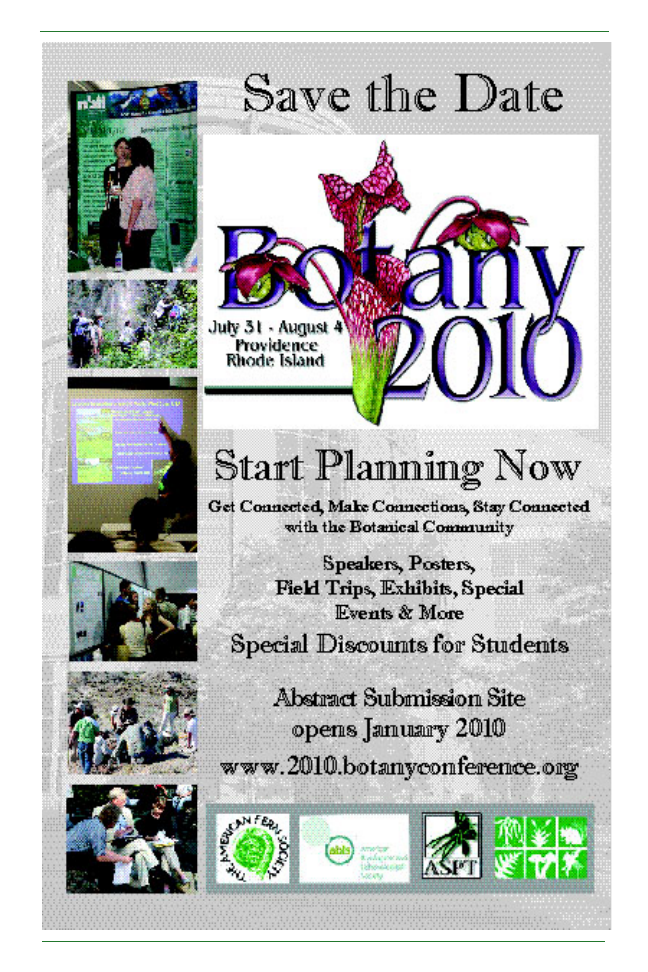
4 8
Plant Science Bulletin 56(1) 2010